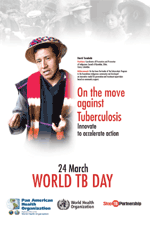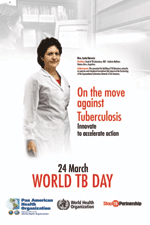Chapter 2 – From Goals to Results
MDG-1 Eradicate Hunger
 As indicated in Chapter 1, more than half of Latin American and Caribbean countries and territories appear to be on track at the national level to achieve the official MDG targets for hunger. Yet progress varies across and within countries. Moreover, acute malnutrition has re-emerged as a problem in several countries, and scant reductions have been achieved in micronutrient deficiencies.
As indicated in Chapter 1, more than half of Latin American and Caribbean countries and territories appear to be on track at the national level to achieve the official MDG targets for hunger. Yet progress varies across and within countries. Moreover, acute malnutrition has re-emerged as a problem in several countries, and scant reductions have been achieved in micronutrient deficiencies.
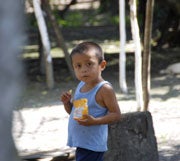 Since 2006, PAHO/WHO has provided technical cooperation in this area within the framework of the Regional Strategy and Plan of Action on Nutrition in Health and Development 2006-2015 (CD47.R8, 2006), the Global Strategy for Infant and Young Child Feeding (WHO/UNICEF, 2003), and the International Code of Marketing of Breast-milk Substitutes (WHO, 1981). In 2010, PAHO’s 50th Directing Council approved the Strategy and Plan of Action for the Reduction of Chronic Malnutrition (CD50.R11), with the intent of strengthening activities proposed in the 2006 regional strategy through an integrated, intersectoral approach that addresses the social determinants of chronic malnutrition and incorporates proven interventions into primary health care. PAHO/WHO promoted this new strategy throughout 2010-2011 and supported its implementation in nine member countries: Belize, the Dominican Republic, El Salvador, Guatemala, Honduras, Nicaragua, Panama, Paraguay, and Peru.
Since 2006, PAHO/WHO has provided technical cooperation in this area within the framework of the Regional Strategy and Plan of Action on Nutrition in Health and Development 2006-2015 (CD47.R8, 2006), the Global Strategy for Infant and Young Child Feeding (WHO/UNICEF, 2003), and the International Code of Marketing of Breast-milk Substitutes (WHO, 1981). In 2010, PAHO’s 50th Directing Council approved the Strategy and Plan of Action for the Reduction of Chronic Malnutrition (CD50.R11), with the intent of strengthening activities proposed in the 2006 regional strategy through an integrated, intersectoral approach that addresses the social determinants of chronic malnutrition and incorporates proven interventions into primary health care. PAHO/WHO promoted this new strategy throughout 2010-2011 and supported its implementation in nine member countries: Belize, the Dominican Republic, El Salvador, Guatemala, Honduras, Nicaragua, Panama, Paraguay, and Peru.
One of the key elements of the new strategy is its endorsement of the Pan American Alliance for Nutrition and Development (PAND). Established in 2008 by the UN Regional Directors Team (UNDG-LAC), PAND facilitates inter-agency cooperation on evidence-based, interprogrammatic, and multisector interventions to tackle the multiple causes of malnutrition.
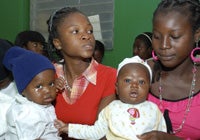 To promote the PAND approach elsewhere in the Region, PAHO/WHO organized meetings with health and other government authorities, civil society organizations, and international NGOs in countries including Argentina, Bolivia, Guatemala, Panama, Paraguay, and Peru.
To promote the PAND approach elsewhere in the Region, PAHO/WHO organized meetings with health and other government authorities, civil society organizations, and international NGOs in countries including Argentina, Bolivia, Guatemala, Panama, Paraguay, and Peru.
A number of other initiatives on food and nutritional security and child malnutrition were also supported. These included micronutrient supplementation and food fortification in 11 countries (Belize, Costa Rica, the Dominican Republic, Ecuador, El Salvador, Guatemala, Honduras, Nicaragua, Panama, and Peru), the construction of a national database of children suffering from acute malnutrition in Guatemala, and a national survey of target populations in Nicaragua.
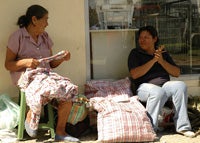 The Caribbean Food and Nutrition Institute (CFNI) developed and promoted a new Regional Protocol for the Detection, Prevention, and Treatment of Anemia in Maternal and Child Health Clinics in the Caribbean. It takes into account the high prevalence of anemia in some countries of the subregion as well as current programs, recent research, and international recommendations on anemia in pregnant women and young children in the maternal and child health clinical setting. The protocol emphasizes screening, supplementation, and the use of iron-rich and fortified foods as well as public health measures such as control of malarial and other parasites. It includes procedures for diagnosis and assessment as well as detection, prevention, and management of anemia at various life stages, particularly vulnerable periods such as pregnancy, post-partum, infancy, and early childhood.
The Caribbean Food and Nutrition Institute (CFNI) developed and promoted a new Regional Protocol for the Detection, Prevention, and Treatment of Anemia in Maternal and Child Health Clinics in the Caribbean. It takes into account the high prevalence of anemia in some countries of the subregion as well as current programs, recent research, and international recommendations on anemia in pregnant women and young children in the maternal and child health clinical setting. The protocol emphasizes screening, supplementation, and the use of iron-rich and fortified foods as well as public health measures such as control of malarial and other parasites. It includes procedures for diagnosis and assessment as well as detection, prevention, and management of anemia at various life stages, particularly vulnerable periods such as pregnancy, post-partum, infancy, and early childhood.
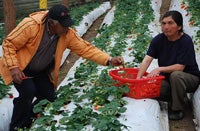 In Cuba, the focus was on strengthening surveillance, prevention, and care of pregnant women and children under 5 with anemia and the design of a nutritional surveillance of anemia component for the country’s Maternal-Child Health Observatories. In Bolivia, the Organization supported a program to detect and treat anemia in pregnant women, nursing babies, children under 5, and school-age children. Technical cooperation was also provided to incorporate anemia prevention into Haiti’s Free Obstetric Care (SOG) program.
In Cuba, the focus was on strengthening surveillance, prevention, and care of pregnant women and children under 5 with anemia and the design of a nutritional surveillance of anemia component for the country’s Maternal-Child Health Observatories. In Bolivia, the Organization supported a program to detect and treat anemia in pregnant women, nursing babies, children under 5, and school-age children. Technical cooperation was also provided to incorporate anemia prevention into Haiti’s Free Obstetric Care (SOG) program.
A number of efforts took place to advance MDG-1 within the framework of the Faces, Voices, and Places (FVP) initiative. In Brazil’s countryside, for example, it helped revitalize the Association of Producers of Olinda-Amparo and implement a program to cultivate medicinal plants. FVP also supported the country’s Health in Schools Program with nutritional evaluations and orientation for children and teens in 20 schools.
In the El Chaco region of Argentina, Bolivia, and Paraguay, FVP supported training for small farmers and livestock producers; organized women producers of fruits and vegetables, bread, and crafts; and promoted food gardens in schools to improve child nutrition.
In Cuba, the Institute of Veterinary Medicine and local authorities implemented a “productive municipalities” strategy aimed at improving food and nutritional security. The strategy, implemented on a pilot basis in four municipal districts, supports families engaged in farming and animal husbandry and includes a new model for providing veterinary care.
 Other nutrition-related technical cooperation included evaluations by CFNI of school feeding programs in Jamaica, St. Vincent and the Grenadines, and Trinidad and Tobago and technical assistance to develop and publish food service manuals and cycle menus for use in schools. In addition, the Organization provided support for breastfeeding promotion, “baby-friendly hospitals,” and the new WHO Child Growth Standards, described in more detail under MDG-4 below.
Other nutrition-related technical cooperation included evaluations by CFNI of school feeding programs in Jamaica, St. Vincent and the Grenadines, and Trinidad and Tobago and technical assistance to develop and publish food service manuals and cycle menus for use in schools. In addition, the Organization provided support for breastfeeding promotion, “baby-friendly hospitals,” and the new WHO Child Growth Standards, described in more detail under MDG-4 below.
MDG-3 Promote Gender Equality and Empower Women
Gender remains a key social determinant in the Americas, not only of socioeconomic inequality but also of health status and prospects. PAHO/WHO work in this area seeks to increase gender equality in health as a matter of social justice but also addresses the differences between the health needs and risks of men and women, boys and girls to improve the coverage, effectiveness, efficiency, and impact of health interventions.
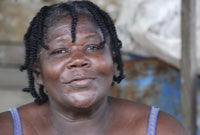 The framework for technical cooperation in this area is the 2005 PAHO Gender Equality Policy (CD46/12) and the 2009 Regional Plan of Action for Implementing the Gender Equality Policy. These guide PAHO/WHO’s technical cooperation in its member countries as well as its own human resources management, strategic planning, monitoring, and evaluation.
The framework for technical cooperation in this area is the 2005 PAHO Gender Equality Policy (CD46/12) and the 2009 Regional Plan of Action for Implementing the Gender Equality Policy. These guide PAHO/WHO’s technical cooperation in its member countries as well as its own human resources management, strategic planning, monitoring, and evaluation.
The Organization supported the development and implementation of gender equality plans in Bolivia, Guatemala, Nicaragua, Paraguay, and Suriname. Letters of agreement were signed with the Council of Ministers for Women in Central America (COMMCA) and the Council of Ministers of Health of Central America (COMISCA) to mainstream gender in the Central American Integration System (SICA).
In the Andean Region, a participatory process for defining key indicators on gender and health led to a proposal to include them as part of the social indicators used by the Andean Community.
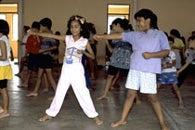 In Nicaragua, the Organization supported the design and initial implementation of a project on gender and chronic disease that addresses the legal and social barriers to girls’ participation in sports and physical activity, to improve their well-being and decrease their risks for obesity and chronic disease.
In Nicaragua, the Organization supported the design and initial implementation of a project on gender and chronic disease that addresses the legal and social barriers to girls’ participation in sports and physical activity, to improve their well-being and decrease their risks for obesity and chronic disease.
In other technical cooperation in this area, gender-equality guidelines were used to review a proposal to the Global Fund by RedTransSex, a South American network of sex workers, and a proposal and interview guide to study gender aspects of multidrug resistant TB (MDR-TB) were finalized in Peru.
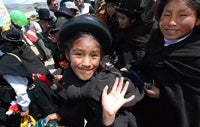 The Organization collaborated on several publications in this area that were launched during 2010-2011, including Profile on Gender and Health in the Andean Subregion, Profile on Gender and Health for the Republic of Panama, Health of Men and Women in Central America and the Dominican Republic, and a statistical brochure on gender, health, and development in Costa Rica. In addition, the Organization launched a new virtual course on gender and health with a focus on human rights and cultural diversity, which is now available through the Virtual Public Health Campus.
The Organization collaborated on several publications in this area that were launched during 2010-2011, including Profile on Gender and Health in the Andean Subregion, Profile on Gender and Health for the Republic of Panama, Health of Men and Women in Central America and the Dominican Republic, and a statistical brochure on gender, health, and development in Costa Rica. In addition, the Organization launched a new virtual course on gender and health with a focus on human rights and cultural diversity, which is now available through the Virtual Public Health Campus.
In March 2011, during an event marking International Women’s Day, PAHO/WHO honored the winners of the 4th annual “Best Practices that Incorporate the Perspective of Gender Equality in Health” contest, which focused on HIV prevention, care, and treatment. The winners were an Argentine initiative that promotes sexual and reproductive health and prevention of HIV in adolescents from marginal neighborhoods, and an initiative from Trinidad and Tobago that provides counseling and treatment for couples with only one member who is HIV-positive.
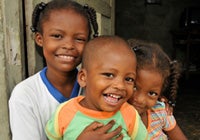 As part of its Gender, Diversity, and Human Rights program, the Organization also promoted the health and human rights of indigenous peoples. This work included technical support for the Andean Intercultural Plan on Indigenous Health and the Andean Intercultural Plan on Afro-descendants, as well as a technical cooperation between countries (TCC) project between Colombia and Brazil to promote health among the Rom people.
As part of its Gender, Diversity, and Human Rights program, the Organization also promoted the health and human rights of indigenous peoples. This work included technical support for the Andean Intercultural Plan on Indigenous Health and the Andean Intercultural Plan on Afro-descendants, as well as a technical cooperation between countries (TCC) project between Colombia and Brazil to promote health among the Rom people.
In coordination with ECLAC’s Latin American and Caribbean Demographic Center (CELADE) and UNFPA, PAHO/WHO collaborated with experts on indigenous and Afro-descendant affairs from ministries of health and civil society to develop a first draft of a recommendation to include ethnic/racial identification into health statistics, based on experiences in the Americas.
In May 2011, the Organization chaired the Inter-Agency Support Group on Indigenous Peoples’ Issues during the 10th session of the UN Permanent Forum on Indigenous Issues in New York and helped organize a side event on noncommunicable diseases in indigenous communities.
A new CD and a written guide to the United Nations Declaration on the Rights of Indigenous Peoples and ILO Convention 169 for civil society organizations, governments, UN agencies, and other stakeholders were also launched.
MDG-4 Reduce Child Mortality
 As noted in Chapter 1, Latin America and the Caribbean have the lowest infant mortality of any developing region as well as the fastest rate of decline in this indicator since 1990. But while the Region as a whole is on track to achieve MDG-4, progress has been uneven across and within countries. Technical cooperation in this area focused on consolidating gains already achieved and accelerating progress in countries and population groups that are lagging behind.
As noted in Chapter 1, Latin America and the Caribbean have the lowest infant mortality of any developing region as well as the fastest rate of decline in this indicator since 1990. But while the Region as a whole is on track to achieve MDG-4, progress has been uneven across and within countries. Technical cooperation in this area focused on consolidating gains already achieved and accelerating progress in countries and population groups that are lagging behind.
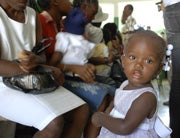 Much of the work in this area is aimed at reducing neonatal mortality, that is, deaths within the first 28 days of life, which currently accounts for some 60 percent of mortality among children under 1 in the Region. The Regional Strategy and Plan of Action for Neonatal Health within the Continuum of Maternal, Newborn, and Child Care (CD48/7), approved in 2008 by PAHO’s 48th Directing Council, addresses care throughout the life cycle, including adolescence, preconception, pregnancy, childbirth, and childhood, not only in health clinics and hospitals but also in the home and the community.
Much of the work in this area is aimed at reducing neonatal mortality, that is, deaths within the first 28 days of life, which currently accounts for some 60 percent of mortality among children under 1 in the Region. The Regional Strategy and Plan of Action for Neonatal Health within the Continuum of Maternal, Newborn, and Child Care (CD48/7), approved in 2008 by PAHO’s 48th Directing Council, addresses care throughout the life cycle, including adolescence, preconception, pregnancy, childbirth, and childhood, not only in health clinics and hospitals but also in the home and the community.
A central focus of the strategy is care provided during the critical hours after childbirth, when a baby’s survival depends in large part on the skilled attendant who cares for both mother and child. The action plan stresses well-known cost-effective interventions, including IMCI interventions, as well as investments to strengthen health systems, with special attention to training and deployment of health professionals, including doctors, midwives, and nurses.
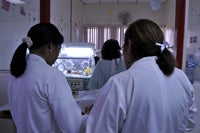 Based on the regional strategy, technical cooperation to member countries sought to develop and implement neonatal health plans. In Brazil, Bolivia, the Dominican Republic, El Salvador, Guatemala, Honduras, Nicaragua, and Peru, the Organization helped incorporate evidenced-based neonatal interventions into norms and procedures for maternal and child care. In Guyana, it helped implement a course on “Essential Care of the Newborn” and developed a neonatal nursing care curriculum as part of the Magnet Hospital project.
Based on the regional strategy, technical cooperation to member countries sought to develop and implement neonatal health plans. In Brazil, Bolivia, the Dominican Republic, El Salvador, Guatemala, Honduras, Nicaragua, and Peru, the Organization helped incorporate evidenced-based neonatal interventions into norms and procedures for maternal and child care. In Guyana, it helped implement a course on “Essential Care of the Newborn” and developed a neonatal nursing care curriculum as part of the Magnet Hospital project.
A WHO-recommended methodology was used in the development of neonatal and child health profiles for six countries: Ecuador, the Dominican Republic, Guatemala, Honduras, Nicaragua, and Panama. The profiles utilized data disaggregated by geographical area (departments or provinces and municipalities) to provide a baseline for monitoring MDG progress and for planning and prioritizing activities and investments aimed at reducing neonatal, infant, child, and maternal mortality at the subnational and local levels.
A regional training module on monitoring, supervision, and evaluation of neonatal health in hospitals and other health facilities was developed, with six countries currently using the instrument to improve neonatal services: Bolivia, the Dominican Republic, Ecuador, Guatemala, Nicaragua, and Panama.
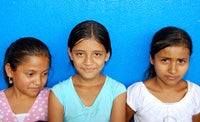 At the regional level, the Organization strengthened coordination with other agencies working on child health through monthly meetings of the Latin America and Caribbean Newborn Health Alliance, whose members also include UNICEF, USAID, Save the Children, Plan International, the CORE Group, the Latin American Pediatrics Association (ALAPE), the Pan American Federation of Nursing Professionals (FEPPEN), and the Latin American Federation of Obstetrics and Gynecology Societies (FLASOG).
At the regional level, the Organization strengthened coordination with other agencies working on child health through monthly meetings of the Latin America and Caribbean Newborn Health Alliance, whose members also include UNICEF, USAID, Save the Children, Plan International, the CORE Group, the Latin American Pediatrics Association (ALAPE), the Pan American Federation of Nursing Professionals (FEPPEN), and the Latin American Federation of Obstetrics and Gynecology Societies (FLASOG).
To better coordinate child health efforts among different international agencies, academic institutions, and NGOs working in the same country, the Organization helped establish “national inter-agency alliances” for child health in six countries: Bolivia, the Dominican Republic, El Salvador, Guatemala, Nicaragua, and Peru. Similar alliances are expected to be established in another six countries by the end of 2011: Colombia, Ecuador, Guyana, Honduras, Panama, and Paraguay.
An important focus of IMCI-related technical cooperation was monitoring of early child development as part of routine primary health care. PAHO/WHO developed a generic regional instrument that was being used in eight countries: Argentina, Brazil, Chile, the Dominican Republic, Guatemala, Nicaragua, Paraguay, and Peru.
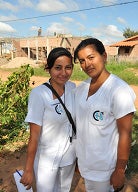 The Organization also promoted the incorporation of IMCI into pediatrics curricula in medical schools, with a focus on students in their final year, who typically are required to serve for several months in rural or vulnerable communities. At least nine countries were using IMCI in medical education: Argentina, Brazil, Bolivia, the Dominican Republic, Ecuador, Guatemala, Nicaragua, Peru, and Uruguay.
The Organization also promoted the incorporation of IMCI into pediatrics curricula in medical schools, with a focus on students in their final year, who typically are required to serve for several months in rural or vulnerable communities. At least nine countries were using IMCI in medical education: Argentina, Brazil, Bolivia, the Dominican Republic, Ecuador, Guatemala, Nicaragua, Peru, and Uruguay.
Similarly, IMCI content was incorporated into nursing curricula in 10 countries: Argentina, Chile, Cuba, the Dominican Republic, El Salvador, Guatemala, Nicaragua, Panama, Peru, and Uruguay.
In addition, distance-learning tools were disseminated to allow countries to train larger numbers of health personnel in evidence-based interventions.
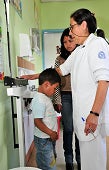 Efforts in the area of nutrition also contributed to improving child health, including the promotion of the WHO Child Growth Standards and the introduction of measurement of height in a number of countries that previously did not use this indicator. Colombia, Ecuador, Haiti, Honduras, Nicaragua, and Suriname were among countries whose health systems adopted and implemented the new standards.
Efforts in the area of nutrition also contributed to improving child health, including the promotion of the WHO Child Growth Standards and the introduction of measurement of height in a number of countries that previously did not use this indicator. Colombia, Ecuador, Haiti, Honduras, Nicaragua, and Suriname were among countries whose health systems adopted and implemented the new standards.
Promotion of breastfeeding was advocated as the single most effective intervention for increasing child survival. This included support for “baby-friendly hospitals”—that is, hospitals that promote practices consistent with optimal breastfeeding of infants—in Bolivia, Costa Rica, the Dominican Republic, Ecuador, Honduras, Panama, and Paraguay.
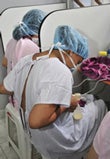 In addition, the Organization supported the establishment and promotion of milk banks in countries including Costa Rica, Cuba, the Dominican Republic, and Nicaragua, as well as in Guatemala, where new milk banks were established in hospitals in areas with high rates of acute malnutrition. PAHO/WHO also supported monitoring of the Code of Marketing of Breast-milk Substitutes in Ecuador, Panama, and Peru and published a 30-year retrospective on the code in Latin American countries, which summarized important legislative actions and the current status of the code in each country.
In addition, the Organization supported the establishment and promotion of milk banks in countries including Costa Rica, Cuba, the Dominican Republic, and Nicaragua, as well as in Guatemala, where new milk banks were established in hospitals in areas with high rates of acute malnutrition. PAHO/WHO also supported monitoring of the Code of Marketing of Breast-milk Substitutes in Ecuador, Panama, and Peru and published a 30-year retrospective on the code in Latin American countries, which summarized important legislative actions and the current status of the code in each country.
A key focus of technical cooperation on MDG-4 was monitoring and surveillance of childhood diseases and mortality. Examples included support for auditing of infant mortality at the subnational level in Costa Rica, capacity-building for surveillance of cholera and other diarrheal diseases in the Bahamas, and a system for continuous monitoring of children’s health in daycare centers, preschools, and primary schools in Montserrat.
Immunization
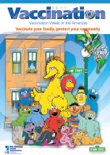 The Organization’s continuing support for immunization in its member countries is fundamental to successful efforts to reduce child mortality. In 2011, Vaccination Week in the Americas celebrated its ninth anniversary, with 43 countries and territories of the Americas participating, reaching 41 million children and adults with vaccines against common childhood diseases as well as other infectious diseases.
The Organization’s continuing support for immunization in its member countries is fundamental to successful efforts to reduce child mortality. In 2011, Vaccination Week in the Americas celebrated its ninth anniversary, with 43 countries and territories of the Americas participating, reaching 41 million children and adults with vaccines against common childhood diseases as well as other infectious diseases.
 Click here to find out more about Vaccination Week in the Americas on the web
Click here to find out more about Vaccination Week in the Americas on the web
As a result of global outreach efforts, parallel vaccination weeks were held simultaneously in 2011 in four other regions besides the Americas: Europe, the Eastern Mediterranean, Africa, and the Western Pacific, with a total of more than 180 countries and territories participating in vaccination week events. By mid-2011, planning was under way for a proposed global vaccination week in 2012, which would coincide with the 10th anniversary of Vaccination Week in the Americas.
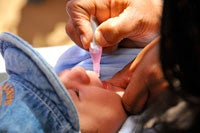 Important immunization support was provided through the Revolving Fund for Vaccine Procurement, the ProVac Initiative, and training and technical assistance in all aspects of immunization, from procurement and cold chain maintenance to surveillance and the identification and targeting of priority population groups.
Important immunization support was provided through the Revolving Fund for Vaccine Procurement, the ProVac Initiative, and training and technical assistance in all aspects of immunization, from procurement and cold chain maintenance to surveillance and the identification and targeting of priority population groups.
In Colombia, for example, the Organization supported a review of vaccination coverage by cohorts since 2002 and helped estimate the accumulation of susceptible populations. On the basis of that review, Colombia carried out an immunization effort in 2010 that targeted all children ages 1 to 8—more than 6 million children—with measles and rubella vaccine.
Similarly, activities in the Bahamas and Turks and Caicos included training for immunization personnel, technical advice and guidance to national surveillance committees, and logistical support for procurement and shipment of vaccines.
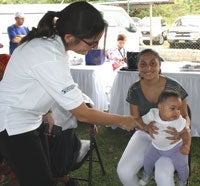 The Revolving Fund for Vaccine Procurement provided vital support for countries’ immunization efforts. During 2010 and the first half of 2011, the fund purchased nearly US$723 million in vaccines, syringes, and cold chain supplies on behalf of 40 countries and territories: Anguilla, Antigua, Argentina, Aruba, Bahamas, Barbados, Belize, Bermuda, Bolivia, Brazil, Cayman Islands, Chile, Colombia, Costa Rica, Cuba, Curaçao, Dominica, the Dominican Republic, Ecuador, El Salvador, Grenada, Guatemala, Guyana, Honduras, Jamaica, Montserrat, Nicaragua, Panama, Paraguay, Peru, St. Kitts and Nevis, St. Lucia, St. Maarten, St. Vincent, Suriname, Trinidad and Tobago, Turks and Caicos, Uruguay, Venezuela, and the British Virgin Islands.
The Revolving Fund for Vaccine Procurement provided vital support for countries’ immunization efforts. During 2010 and the first half of 2011, the fund purchased nearly US$723 million in vaccines, syringes, and cold chain supplies on behalf of 40 countries and territories: Anguilla, Antigua, Argentina, Aruba, Bahamas, Barbados, Belize, Bermuda, Bolivia, Brazil, Cayman Islands, Chile, Colombia, Costa Rica, Cuba, Curaçao, Dominica, the Dominican Republic, Ecuador, El Salvador, Grenada, Guatemala, Guyana, Honduras, Jamaica, Montserrat, Nicaragua, Panama, Paraguay, Peru, St. Kitts and Nevis, St. Lucia, St. Maarten, St. Vincent, Suriname, Trinidad and Tobago, Turks and Caicos, Uruguay, Venezuela, and the British Virgin Islands.
The ProVac Initiative, financed by the Bill & Melinda Gates Foundation, continued to help countries gather and analyze evidence for decision-making on the introduction of new vaccines. ProVac carried out activities in Argentina, Bolivia, Ecuador, Guatemala, Jamaica, Nicaragua, and Paraguay. This included advocacy for evidence-based decision-making on vaccine introduction, training for multidisciplinary national teams in data collection and economic analysis, and guidance in planning the effective introduction of new vaccines when warranted by the evidence.
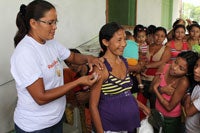 ProVac also supported the activities of its six Centers of Excellence, housed in academic institutions in Argentina, Brazil, Colombia, and Mexico. Their work included developing tools and methodologies to help countries perform national-level economic analyses concerning both new vaccine introduction and broader immunization policy.
ProVac also supported the activities of its six Centers of Excellence, housed in academic institutions in Argentina, Brazil, Colombia, and Mexico. Their work included developing tools and methodologies to help countries perform national-level economic analyses concerning both new vaccine introduction and broader immunization policy.
PAHO/WHO continued its close collaboration with the GAVI Alliance, which provides financing for vaccines in priority countries. In 2010-2011, GAVI financed rotavirus vaccines for Bolivia, Guyana, Honduras, and Nicaragua and pneumococcal vaccines for Guyana, Honduras, and Nicaragua. For its part, PAHO/WHO implemented a one-year moratorium during 2010 on the purchase of 10-valent pneumococcal vaccine (PCV10) to support GAVI’s Advanced Market Commitment (AMC) for pneumococcal vaccines, which seeks to accelerate access to these vaccines by GAVI-eligible countries.
As a result of all these efforts, 13 countries and territories introduced new childhood vaccines into their immunization programs during 2010-2011. These included rotavirus vaccine in Guatemala, Guyana, and Paraguay and pneumococcal conjugate vaccine (PCV7) in Aruba, Brazil, Chile, Colombia, Curaçao, Ecuador, El Salvador, Guyana, Honduras, Nicaragua, and Panama. In addition, Peru introduced the human papilloma virus (HPV) vaccine in early 2011.
 The process of verifying the Region’s elimination of measles, rubella, and congenital rubella syndrome (CRS)—important areas of progress toward MDG-4—continued during this period. The last endemic case of measles in the Americas was reported in 2002, and the last case of rubella in 2009. The Region’s countries have set the goal of verifying the elimination of these diseases by the end of 2012.
The process of verifying the Region’s elimination of measles, rubella, and congenital rubella syndrome (CRS)—important areas of progress toward MDG-4—continued during this period. The last endemic case of measles in the Americas was reported in 2002, and the last case of rubella in 2009. The Region’s countries have set the goal of verifying the elimination of these diseases by the end of 2012.
During 2010, the Organization convened the first meeting of an international expert committee to oversee the verification process and then supported national-level verification commissions in gathering and analyzing data on these diseases in their own countries. In March 2011, the presidents of national-level commissions met with members of the international expert committee to discuss verification efforts so far and the work that remains to complete the process.
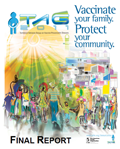 In June 2011, a meeting of a special working group was held to assess the situation of mumps in the Americas and to make suggestions for improving control and response strategies based on country experiences. The group’s recommendations were endorsed during the 19th meeting of the Technical Advisory Group (TAG) on Vaccine Preventable Diseases, held in July 2011 in Buenos Aires.
In June 2011, a meeting of a special working group was held to assess the situation of mumps in the Americas and to make suggestions for improving control and response strategies based on country experiences. The group’s recommendations were endorsed during the 19th meeting of the Technical Advisory Group (TAG) on Vaccine Preventable Diseases, held in July 2011 in Buenos Aires.
 Click here to find out more about the Technical Advisory Group on the web
Click here to find out more about the Technical Advisory Group on the web
The Organization also supported the implementation of effective and timely strategies to handle rumors and events supposedly attributable to vaccination and immunization (ESAVI), with the objective of maintaining public trust in vaccines and immunization programs.
Technical cooperation in this area also included support for countries’ efforts to develop and improve national electronic nominal immunization registries. A workshop in Bogotá, Colombia, in February 2011 brought experts from more than 20 countries together with representatives of partner agencies including UNICEF, PATH, CDC, the Sustainable Sciences Institute, and the Latin American Open Source Health Informatics Group. An outcome was the creation of a community of practice, through which workshop participants and other experts in this field can share problems, lessons learned, and best practices.
MDG-5 Improve Maternal Health
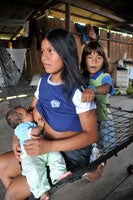 As discussed in Chapter 1, maternal mortality declined some 40 percent from 1990 to 2008 in the Americas as a whole, but not all countries shared in those gains, and current indicators vary dramatically across different countries. Continuous work with member countries was undertaken to improve maternal health within the framework of the 2002 Regional Strategy for Maternal Mortality and Morbidity Reduction (CSP26.R13), the 2008 Regional Strategy for Improving Adolescent and Youth Health (CD48.R5), and the 2008 Regional Strategy and Plan of Action for Neonatal Health within the Continuum of Maternal, Newborn, and Child Care (CD48.R4).
As discussed in Chapter 1, maternal mortality declined some 40 percent from 1990 to 2008 in the Americas as a whole, but not all countries shared in those gains, and current indicators vary dramatically across different countries. Continuous work with member countries was undertaken to improve maternal health within the framework of the 2002 Regional Strategy for Maternal Mortality and Morbidity Reduction (CSP26.R13), the 2008 Regional Strategy for Improving Adolescent and Youth Health (CD48.R5), and the 2008 Regional Strategy and Plan of Action for Neonatal Health within the Continuum of Maternal, Newborn, and Child Care (CD48.R4).
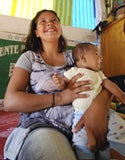 An important complement to the regional framework was the launch in 2010 of the Safe Motherhood Initiative, a call for the countries of the Americas to redouble their efforts to achieve MDG-5. In addition, during 2010-2011 PAHO/WHO and its technical center in this field, the Latin American Center for Perinatology, Women and Reproductive Health (CLAP/WR), developed the new Plan of Action to Accelerate the Reduction of Maternal Mortality and Severe Maternal Morbidity, for presentation to the 51st PAHO Directing Council in September 2011.
An important complement to the regional framework was the launch in 2010 of the Safe Motherhood Initiative, a call for the countries of the Americas to redouble their efforts to achieve MDG-5. In addition, during 2010-2011 PAHO/WHO and its technical center in this field, the Latin American Center for Perinatology, Women and Reproductive Health (CLAP/WR), developed the new Plan of Action to Accelerate the Reduction of Maternal Mortality and Severe Maternal Morbidity, for presentation to the 51st PAHO Directing Council in September 2011.
The Safe Motherhood Initiative—which is also supported by the Regional Inter-Agency Task Force for Maternal Mortality Reduction1 (GTR), the OAS, and Spain’s La Caixa Foundation—was the centerpiece of advocacy efforts for MDG-5 during 2010-2011. The initiative seeks to mobilize political will to spur action in countries to accelerate reductions in maternal mortality. It emphasizes universal access to comprehensive reproductive health services; improvements in the quality of prenatal, childbirth, and postpartum care; measures to reduce unsafe abortions and severe maternal illnesses; improvements in information systems; empowerment of women; and the participation of fathers and men as well as communities in protecting and promoting maternal health.
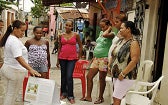 Following the regional launch during the 50th PAHO Directing Council in September 2010, the Safe Motherhood Initiative was launched at the national level in 15 countries: Argentina, Bolivia, Brazil, Colombia, the Dominican Republic, Ecuador, El Salvador, Guatemala, Guyana, Honduras, Nicaragua, Panama, Peru, Suriname, and Uruguay. Additional launches were planned in late 2011 for Mexico and Paraguay.
Following the regional launch during the 50th PAHO Directing Council in September 2010, the Safe Motherhood Initiative was launched at the national level in 15 countries: Argentina, Bolivia, Brazil, Colombia, the Dominican Republic, Ecuador, El Salvador, Guatemala, Guyana, Honduras, Nicaragua, Panama, Peru, Suriname, and Uruguay. Additional launches were planned in late 2011 for Mexico and Paraguay.
A special photo exhibit by Spanish photojournalist Bru Rovira, sponsored by La Caixa Foundation was displayed in Washington, D.C., and during country launches in Argentina, the Dominican Republic, Ecuador, El Salvador, Guatemala, Guyana, Honduras, Nicaragua, and Suriname. In addition, two contests were organized in 2011, one to illustrate the rights of mothers and newborns in the Americas to attain the highest possible standard of health and the other to recognize best practices in reducing maternal mortality.
At the country level, technical cooperation ranged from protocols and training on obstetric care to support for surveillance, reorientation of health services, and advocacy for the rights of users to comprehensive and high-quality sexual and reproductive health care. A key focus of interest was expanding access to and improving health services within the continuum of care, from pre-pregnancy through childbirth and post-partum.
In Colombia, gynecologists, general practitioners, and nurses received training on comprehensive care of pregnant women with a focus on obstetric hemorrhage, hypertensive disorders, and sepsis, which account for 60-70 percent of maternal deaths and illnesses. Between 2009 and mid-2011, workshops had provided training for some 400 participants from health facilities identified as needing quality-of-care improvements.
Argentina’s Ministry of Health implemented a national strategic plan to reduce maternal and child mortality and developed a strategy to regionalize perinatal health services, which was subsequently implemented in the province of Buenos Aires. Similarly, in Costa Rica, the Ministry of Health strengthened planning at the regional and local levels in the country’s South region, to improve survival among mothers and children under 5.
In Ecuador, the Organization continued to support implementation of the Plan for Accelerated Reduction of Maternal and Neonatal Deaths, launched in 2008 with UNFPA and nongovernmental partners. The plan stresses informed access to contraception, particularly to prevent adolescent pregnancies; the organization of intra- and inter-institutional networks for Essential Obstetric and Neonatal Care (CONE); epidemiological surveillance; improved quality of care; and mechanisms to increase demand for services using a rights- and equity-based approach.
El Salvador launched the National Strategic Plan for the Reduction of Maternal and Neonatal Mortality, updated guides on family planning and care within the life cycle, and developed a Sexual and Reproductive Health Policy. As part of these efforts, PAHO/WHO partnered with the Ministry of Health, Enfants du Monde, and the Concertación Educativa de El Salvador to implement the Program to Empower Women, Families and Communities (MIFC), which develops capacities in individuals and communities that lead to greater demand for and better-quality health services.
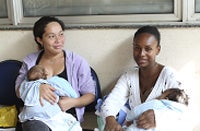 Venezuela initiated the development and implementation of a new Plan for Accelerated Reduction of Maternal Mortality, including updated protocols on routine and emergency obstetric and neonatal care, equipment, and human resources training.
Venezuela initiated the development and implementation of a new Plan for Accelerated Reduction of Maternal Mortality, including updated protocols on routine and emergency obstetric and neonatal care, equipment, and human resources training.
The Ministry of Health of Chile reviewed the child and maternal health programs undertaken the previous decade and developed strategic proposals in these areas for inclusion in the country’s National Health Plan 2011-2020.
In Cuba, efforts focused on improving the quality of pregnancy, childbirth, and post-partum care through training for health providers and help with developing and adapting healthcare guidelines and methodologies. These efforts were instrumental in strengthening Cuba’s network of “maternity homes” and converting them into “maternal-child homes.” The Organization also supported pandemic H1N1 influenza vaccination of pregnant women and at-risk children through a mobilization plan, human resources training, a social communication campaign, and an epidemiological study to evaluate the safety and efficacy of the vaccine in pregnant women.
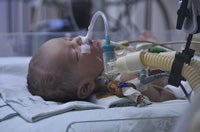 In Guyana, the Organization helped carry out a Make Pregnancy Safer project financed by WHO, the European Community, and the African, Caribbean and Pacific Group of States (ACP). Activities in 2010-2011 included training in emergency obstetric and neonatal care and advanced labor and risk management (ALARM) for 60 health professionals in collaboration with the Society of Obstetricians and Gynaecologists of Canada. It also included training in neonatal resuscitation (“Helping Babies Breathe”) for midwives and other health professionals in collaboration with the Church of Jesus Christ of Latter-day Saints. Guyana was also supported in developing national strategic plans for maternal, neonatal, child, and adolescent and youth health for 2011-2015.
In Guyana, the Organization helped carry out a Make Pregnancy Safer project financed by WHO, the European Community, and the African, Caribbean and Pacific Group of States (ACP). Activities in 2010-2011 included training in emergency obstetric and neonatal care and advanced labor and risk management (ALARM) for 60 health professionals in collaboration with the Society of Obstetricians and Gynaecologists of Canada. It also included training in neonatal resuscitation (“Helping Babies Breathe”) for midwives and other health professionals in collaboration with the Church of Jesus Christ of Latter-day Saints. Guyana was also supported in developing national strategic plans for maternal, neonatal, child, and adolescent and youth health for 2011-2015.
In the Dominican Republic, the Organization partnered with the Ministry of Health, the Office of the First Lady, the Dominican Medical Association, and CLAP/WR to hold the First International Symposium on the Humanization of Maternal-Child Care in Santo Domingo in January 2011. Some 600 participants attended the symposium, including health authorities, medical faculty and other academicians, representatives of national medical and scientific associations, and private health providers. The symposium led to wider recognition of sexual and reproductive rights and helped produce a consensus among different actors on the need to improve the quality of healthcare services.
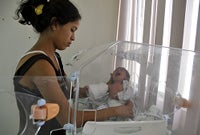 Technical cooperation was also provided to the Dominican Republic for a national survey on women’s perceptions of obstetric and neonatal health services in the public sector, which included questions to assess women’s knowledge of their sexual and reproductive rights and the extent of violations of those rights in maternity health services. The results will be used to design a new strategy to raise awareness in the area of gender equality and respect for women’s rights.
Technical cooperation was also provided to the Dominican Republic for a national survey on women’s perceptions of obstetric and neonatal health services in the public sector, which included questions to assess women’s knowledge of their sexual and reproductive rights and the extent of violations of those rights in maternity health services. The results will be used to design a new strategy to raise awareness in the area of gender equality and respect for women’s rights.
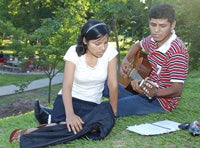 Special efforts were made to improve sexual and reproductive health services using an approach that emphasizes the rights of women and youths to access to comprehensive, quality services that include family planning services.
Special efforts were made to improve sexual and reproductive health services using an approach that emphasizes the rights of women and youths to access to comprehensive, quality services that include family planning services.
In Ecuador, the Organization helped develop a new National Intersectoral Strategy for Family Planning (ENIPLA), which aims to guarantee access to sexual and reproductive health information, counseling, and services, based on constitutional norms. The strategy was developed with support from UNFPA and with the collaboration of the Ministry of Public Health, the Ministry of Education, the Ministry of Economic and Social Inclusion, scientific and nongovernmental organizations, and civil society groups.
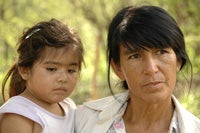 In Argentina, UNICEF, UNFPA and PAHO/WHO partnered to provide technical and financial support for a new Observatory in Sexual and Reproductive Health, which will produce information and knowledge on the promotion of sexual and reproductive health from a human rights perspective. Members of the observatory include the Center for Studies in the State and Society, the Rosarino Center for Perinatal Studies, and the National Academy of Medicine.
In Argentina, UNICEF, UNFPA and PAHO/WHO partnered to provide technical and financial support for a new Observatory in Sexual and Reproductive Health, which will produce information and knowledge on the promotion of sexual and reproductive health from a human rights perspective. Members of the observatory include the Center for Studies in the State and Society, the Rosarino Center for Perinatal Studies, and the National Academy of Medicine.
An inter-agency technical team on sexual and reproductive health was organized in Honduras to develop a common agenda and harmonize efforts among different international agencies working on these issues. It also helped the Ministry of Health update norms and procedures related to family planning, menopause, and infertility; maternal and neonatal care within the continuum of care; and post-abortion care. In partnership with Honduras’s Gynecology and Obstetrics Society, protocols were developed for managing obstetric complications and discussions on post-abortion care were promoted.
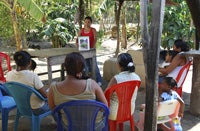 At the request of Argentina, Honduras, and Peru, the Organization’s human rights team presented technical opinions to national courts on the right to access emergency oral contraception as a strategy for reducing maternal mortality.
At the request of Argentina, Honduras, and Peru, the Organization’s human rights team presented technical opinions to national courts on the right to access emergency oral contraception as a strategy for reducing maternal mortality.
In Venezuela, policies and strategies on adolescent health were implemented, including norms on the provision of comprehensive sexual and reproductive health services, including access to contraception. Similarly, Ecuador developed new norms on comprehensive adolescent health care to make health services “friendlier”’ to adolescent girls. These efforts were part of the implementation of the National Plan to Prevent Adolescent Pregnancies and were financed by the Spanish Agency for International Development Cooperation (AECID).
A partnership with the Catholic University of Chile provided distance training in adolescent health—including adolescent pregnancy—for health professionals from Chile and other Latin American countries.
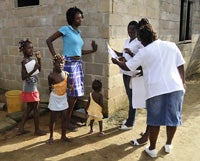 In Suriname, cooperation focused on the introduction of the Joint Action Plan for Women’s and Children’s Health at the Ministry of Health and its incorporation into the Family and Community Health program. PAHO also supported the introduction of the WHO Family Planning Decision Making Tool through training and pilot implementation, as well as the development of an MDG project proposal on maternal health for Suriname as a member of ACP.
In Suriname, cooperation focused on the introduction of the Joint Action Plan for Women’s and Children’s Health at the Ministry of Health and its incorporation into the Family and Community Health program. PAHO also supported the introduction of the WHO Family Planning Decision Making Tool through training and pilot implementation, as well as the development of an MDG project proposal on maternal health for Suriname as a member of ACP.
The Organization backed efforts in several countries to reduce maternal mortality in indigenous communities. This included technical and financial support for community-based maternal-health projects in Machachi and Latacunga, Ecuador, and in Wiwili, Jinotega, Nicaragua. A series of workshops on sexual and reproductive health was organized in Argentina in conjunction with the Indigenous Communication Network, an indigenous women’s organization, while a partnership with UNFPA helped refurbish the Maternity Waiting Home for Amerindian Women in Guyana.
Surveillance and information systems are another important focus of efforts to advance MDG-5. During 2010-2011, CLAP/WR provided technical cooperation to strengthen surveillance of maternal mortality in countries including Colombia, Ecuador, El Salvador, Honduras, and Mexico. In Honduras and Mexico, this included training and consultations with staff responsible for health information and surveillance to support active case-finding of deceased mothers and children under 5 and improved data analysis.
The Organization also provided support for the implementation of CLAP/WR’s Perinatal Information System (SIP), a software system that collects information on pregnant women and babies in the health services, assesses the outcomes of the care they receive, and helps identify common problems and priority areas for improving care. During the period, SIP was implemented or strengthened in the Dominican Republic, El Salvador, Guyana, and Honduras. In the Dominican Republic, CLAP/WR and USAID helped to reactivate SIP in public maternity hospitals.
CLAP/WR also contributed to the creation of a new Central American Network of Perinatal Information Systems (which also includes the Dominican Republic) and supported the development of a related TCC project involving El Salvador, Honduras, Nicaragua, and Panama.
The Ministry of Social Protection of Colombia, in partnership with CLAP/WR and CDC, implemented a web-based surveillance system for maternal mortality, begun in 2008. By mid-2011, the system had been validated in 40 health facilities and in both departmental and municipal health departments. The system has provided complete and timely information on the causes and risk factors for maternal mortality and has helped health officials identify interventions needed to prevent maternal deaths.
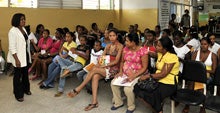 Venezuela updated maternal mortality information systems, developed new methodologies for improving the quality of data, and promoted the use of tools of the Health Metrics Network (Red Métrica de Salud).
Venezuela updated maternal mortality information systems, developed new methodologies for improving the quality of data, and promoted the use of tools of the Health Metrics Network (Red Métrica de Salud).
In addition, CLAP/WR partnered in 2010-2011 with ECLAC, as a member of the GTR, to develop a guide for health teams on how to interpret and utilize existing information on maternal mortality, including WHO estimates, data from articles in peer-reviewed journals, and official data reported by ministries of health in the Region. USAID is providing financial support for the project.
MDG-6 Combat HIV/AIDS, Malaria, and Other Diseases
 As indicated in Chapter 1, new HIV infections in Latin America and the Caribbean have begun to stabilize, although prevalence remains high in the Caribbean, at 1 percent of adults. It is unlikely the Americas as a whole will meet the MDG of halting and reversing the spread of HIV by 2015. However, most countries in the Region continue to make steady progress in promoting HIV prevention and improving and expanding treatment and care.
As indicated in Chapter 1, new HIV infections in Latin America and the Caribbean have begun to stabilize, although prevalence remains high in the Caribbean, at 1 percent of adults. It is unlikely the Americas as a whole will meet the MDG of halting and reversing the spread of HIV by 2015. However, most countries in the Region continue to make steady progress in promoting HIV prevention and improving and expanding treatment and care.
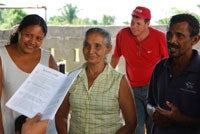 The key frameworks for technical cooperation in this area are Scaling-Up of Treatment within a Comprehensive Response to HIV/AIDS (CD45.11), the Regional Strategic Plan for HIV/AIDS/STI 2006-2015 (CD46.R15), and the 2010 Strategy and Plan of Action for the Elimination of Mother-to-Child Transmission of HIV and Congenital Syphilis (CD50/15). Within these frameworks, the Organization supported efforts to improve health services for people with HIV, increase testing and counseling, expand access to antiretroviral treatment (ART), monitor and prevent drug resistance to ART, strengthen surveillance, and promote prevention, particularly among high-risk and vulnerable groups. PAHO/WHO provided technical cooperation in these areas at the regional, country, and community levels, in close coordination with ministries of health and other partners.
The key frameworks for technical cooperation in this area are Scaling-Up of Treatment within a Comprehensive Response to HIV/AIDS (CD45.11), the Regional Strategic Plan for HIV/AIDS/STI 2006-2015 (CD46.R15), and the 2010 Strategy and Plan of Action for the Elimination of Mother-to-Child Transmission of HIV and Congenital Syphilis (CD50/15). Within these frameworks, the Organization supported efforts to improve health services for people with HIV, increase testing and counseling, expand access to antiretroviral treatment (ART), monitor and prevent drug resistance to ART, strengthen surveillance, and promote prevention, particularly among high-risk and vulnerable groups. PAHO/WHO provided technical cooperation in these areas at the regional, country, and community levels, in close coordination with ministries of health and other partners.
Much of the work on HIV during the period was carried out in conjunction with other UN and international agencies. Examples include collaboration with UNFPA on prevention and care for female sex workers and with the United Nations Educational, Scientific and Cultural Organization (UNESCO) on comprehensive sex education and promotion of sexual health. UNAIDS provided coordinating support for all these efforts as well as for inter-agency cooperation to advance universal access to ART.
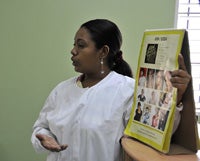 An important development in 2010 was the launch of the Strategy and Plan of Action for the Elimination of Mother-to-Child Transmission of HIV and Congenital Syphilis, approved by PAHO’s 50th Directing Council. It seeks to eliminate mother-to-child transmission of HIV and syphilis as a public health problem in the Americas by 2015, through prevention and control interventions for prenatal, sexual, and reproductive health; improvement of health services; increased collaboration with other agencies and sectors and with the community; improved data collection and analysis; and research.
An important development in 2010 was the launch of the Strategy and Plan of Action for the Elimination of Mother-to-Child Transmission of HIV and Congenital Syphilis, approved by PAHO’s 50th Directing Council. It seeks to eliminate mother-to-child transmission of HIV and syphilis as a public health problem in the Americas by 2015, through prevention and control interventions for prenatal, sexual, and reproductive health; improvement of health services; increased collaboration with other agencies and sectors and with the community; improved data collection and analysis; and research.
Following the launch of the strategy, technical support focused on the implementation of its provisions, in partnership with UNICEF and in coordination with other agencies including UNAIDS, CDC, the Pan Caribbean Partnership against HIV and AIDS (PANCAP), the International Planned Parenthood Federation (IPPF), the Inter-American Development Bank (IDB), and the World Bank.
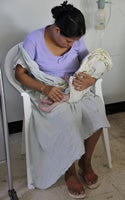 As part of this work, national strategies were developed and implemented in countries including Colombia, Guatemala, Guyana, Haiti, Honduras, Panama, and Venezuela. In Panama, for example, PAHO/WHO partnered with UNICEF and the National Commission for Prevention of Mother-to-Child Transmission of HIV and Syphilis to design and implement a plan that focuses on increased HIV screening for pregnant women and better follow-up of detected cases, as well as improvements in epidemiological surveillance and information systems, and prevention efforts, including communication for behavior change.
As part of this work, national strategies were developed and implemented in countries including Colombia, Guatemala, Guyana, Haiti, Honduras, Panama, and Venezuela. In Panama, for example, PAHO/WHO partnered with UNICEF and the National Commission for Prevention of Mother-to-Child Transmission of HIV and Syphilis to design and implement a plan that focuses on increased HIV screening for pregnant women and better follow-up of detected cases, as well as improvements in epidemiological surveillance and information systems, and prevention efforts, including communication for behavior change.
In Colombia, the Organization partnered with the Ministry of Social Protection, the National Institute of Health, and the Colombian Association of Comprehensive Medical Companies (ACEMI) to develop a similar national plan. The partners then worked with private and public health institutions in Barranquilla, Bogotá, Cali, and Medellín to improve the quality of prenatal care, increase detection and improve reporting of HIV and gestational and congenital syphilis, and properly classify stages of syphilis to facilitate timely and appropriate treatment.
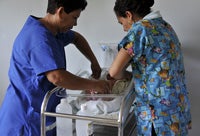 The implementation of similar national strategies in Guatemala, Nicaragua, and Venezuela was supported through training as well as the development and dissemination of guidelines and protocols on treatment and prevention of mother-to-child transmission of HIV and syphilis.
The implementation of similar national strategies in Guatemala, Nicaragua, and Venezuela was supported through training as well as the development and dissemination of guidelines and protocols on treatment and prevention of mother-to-child transmission of HIV and syphilis.
Among the most important HIV-related initiatives was a series of evaluations of health systems’ capacities to provide comprehensive sexual and reproductive care, including prevention of HIV and sexually transmitted infections (STIs) in young people. The evaluations used a participatory approach, involving ministry of health staff from HIV programs, staff responsible for planning and management of health services, and representatives of partner agencies including UNAIDS and the United States President’s Emergency Plan for AIDS Relief (PEPFAR).
Evaluations were carried out in Jamaica, Paraguay, and Trinidad and Tobago. The exercises were designed to identify gaps in ART coverage, assess the cost-effectiveness of interventions, and evaluate sustainability, resulting in recommendations for use in strategic and operational planning. Overall, the results of the evaluations reinforced the premise that efforts to address priority health problems (“vertical” approaches) must go hand in hand with efforts to strengthen health systems.
A number of training initiatives helped improve services for people with HIV. These included training in voluntary counseling and testing, peer education, and social marketing of condoms in Turks and Caicos and, in Guyana, training for 141 health professionals in Integrated Management of Adolescent and Adult Illnesses (IMAI) and a regional workshop to train people with HIV to become “expert patient trainers.”
 The Organization also developed or deployed a number of new training tools for HIV-related capacity-building. One such tool, designed to improve the skills and practices of health workers who care for men who have sex with men, was used in workshops in Guatemala, Mexico, and Peru and on the U.S.-Mexico border during 2010; similar workshops are planned for Central America, the Andean Region, the Southern Cone, and Puerto Rico during 2011. A new tool for peer training of female sex workers on HIV and STI prevention and violence was first used in a workshop held in May 2011 for participants from throughout Central America.
The Organization also developed or deployed a number of new training tools for HIV-related capacity-building. One such tool, designed to improve the skills and practices of health workers who care for men who have sex with men, was used in workshops in Guatemala, Mexico, and Peru and on the U.S.-Mexico border during 2010; similar workshops are planned for Central America, the Andean Region, the Southern Cone, and Puerto Rico during 2011. A new tool for peer training of female sex workers on HIV and STI prevention and violence was first used in a workshop held in May 2011 for participants from throughout Central America.
Other technical cooperation on HIV focused on vulnerable groups, particularly young people, and on high-risk groups who remain at the center of the Region’s HIV epidemic, including men who have sex with men and other sexually diverse people, and sex workers. In Argentina, UNAIDS, UNFPA, UNDP, and PAHO/WHO worked in five hospitals to improve access to testing, counseling, and comprehensive care for men who have sex with men and transgender people. Similar efforts in Venezuela focused on identifying vulnerabilities of these groups to HIV, promoting their human rights, and improving the quality of services they receive. In Honduras, the Organization supported a project that trained and deployed youth communicators to promote prevention among young people using vehicles known as “HIV Preve-mobiles.”
 The Arica-Parinacota region of Chile has the highest HIV incidence and prevalence in the country. UN agencies partnered to carry out a situation analysis of HIV in the region and studies of seroprevalence in men who have sex with men and female sex workers, as well as to support second-generation HIV/AIDS surveillance and promote HIV-related cooperation between Arica and Tacna, across the border in Peru.
The Arica-Parinacota region of Chile has the highest HIV incidence and prevalence in the country. UN agencies partnered to carry out a situation analysis of HIV in the region and studies of seroprevalence in men who have sex with men and female sex workers, as well as to support second-generation HIV/AIDS surveillance and promote HIV-related cooperation between Arica and Tacna, across the border in Peru.
In the Bahamas and Honduras, the Organization supported leadership training and advocacy for men who have sex with men and transgender people, emphasizing a human rights approach. Support was also provided for capacity-building on human rights in relation to HIV, sexual and reproductive health, mental health, indigenous people, and youths in Barbados, Bolivia, El Salvador, Guatemala, Mexico, Panama, and Trinidad and Tobago.
In Guatemala, technical cooperation was provided to the national congress to reform laws related to HIV.
An important focus of technical cooperation related to HIV was improving and expanding access to ART for people who need it. This work included the development of treatment standards and guidelines in El Salvador, Guyana, and Haiti and technical support and training for the organization and operation of 32 ART-dispensing centers in Nicaragua. In Honduras, the Organization partnered with Aidstar One (USAID’s global HIV/AIDS project) to organize a national consultation on improving coverage and testing for HIV.
Critical support for expanding ART coverage was provided by the Regional Revolving Fund for Strategic Public Health Supplies, known as the PAHO Strategic Fund (see also MDG-8 below). Between June 2010 and June 2011, nine countries acquired US$16.1 million worth of antiretroviral medications through the fund, enough treatment for approximately 30,000 patients. Thanks to the fund’s ability to pool demand and negotiate with manufacturers, participating countries paid the reduced price of US$178 for first-line treatment combinations and US$621 for second-line combinations (AZT+3TC+Lop/r). Two countries—Ecuador and Paraguay—purchased third-line ART through the fund during this period.
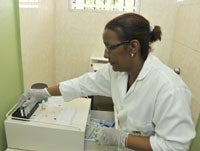 Also pivotal in this area was support for surveillance of ART drug resistance in countries including Guyana, Honduras, Nicaragua, and Venezuela. This support helped Guyana become the first country in Latin America and the Caribbean to establish HIV drug-resistance monitoring based on WHO guidelines.
Also pivotal in this area was support for surveillance of ART drug resistance in countries including Guyana, Honduras, Nicaragua, and Venezuela. This support helped Guyana become the first country in Latin America and the Caribbean to establish HIV drug-resistance monitoring based on WHO guidelines.
Technical cooperation to improve epidemiological surveillance of HIV, STIs, and other infectious diseases was provided in Argentina, the Bahamas, Guyana, Nicaragua, Suriname, Turks and Caicos, and Venezuela. In Nicaragua, this work included improvements in reporting of HIV and congenital and gestational syphilis in health establishments to correct under-reporting cases. The country also improved HIV surveillance data through disaggregation by sex, age, and vulnerable population group (pregnant women, adolescents, and sexually diverse people).
In Argentina, the Organization partnered with UNICEF to support a study on prevalence of HIV and syphilis in pregnant women that provided a baseline for monitoring elimination efforts within the regional framework.
A number of research efforts related to HIV were carried out, including an analysis of the impact of homophobic harassment on risk taking and health among young men who have sex (or presumably have sex) with men and a study of women recently infected with HIV, the findings of which will be used to develop new prevention strategies.
At the country level, the Organization supported a study in Venezuela on the status of access to ART among children with HIV and research in the Bahamas on HIV knowledge, attitudes, practices, and beliefs among 15- to 17-year-olds, the findings of which will inform policymaking and program development. In addition, the Organization hosted a meeting of public health experts to examine evidence on blood-borne and sexually transmitted infections among drug users in Latin America and the Caribbean.
Finally, CFNI in Jamaica promoted nutrition as an important aspect of HIV care and treatment through a special algorithm that reflects current knowledge of the effects of nutrition on the immune system and on patient adherence to medication. The algorithm was adapted for the Caribbean and incorporated into special toolkits for use by healthcare workers. This work supports the shift in the Region from vertical care for people with HIV to a more decentralized model common in the treatment of other chronic diseases.
Malaria
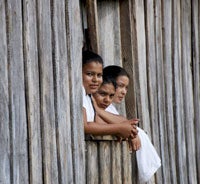 As noted in Chapter 1, the incidence of malaria has declined over the past decade in 18 of 21 endemic countries in the Americas, and in nine countries, the decline was more than 75 percent, effectively attaining the MDG-6 target. Nevertheless, some 17 million people in the Region continue to live in high-risk zones.
As noted in Chapter 1, the incidence of malaria has declined over the past decade in 18 of 21 endemic countries in the Americas, and in nine countries, the decline was more than 75 percent, effectively attaining the MDG-6 target. Nevertheless, some 17 million people in the Region continue to live in high-risk zones.
The Organization continued supporting country efforts to prevent and control malaria within the framework of the Regional Strategic Plan for Malaria in the Americas 2006-2010, while also developing a new Strategy and Plan of Action for Malaria to present to the 51st Directing Council in September/October 2011.
Efforts in this area focused on integrated vector management, diagnosis and treatment, health systems strengthening and capacity-building in surveillance and early detection of outbreaks in both high-risk areas and areas where the risk has declined. The Organization partnered with USAID to support the work of the Amazon Network for the Surveillance of Antimalarial Drug Resistance and the Amazon Malaria Initiative (RAVREDA/AMI) in Bolivia, Brazil, Colombia, Ecuador, Guyana, Peru, Suriname, and Venezuela.
 In Brazil, technical cooperation included support for improvements in surveillance of antimalarial resistance, access and use of antimalarial drugs, quality of drugs, quality of and access to diagnosis, entomology and integral vector control, epidemiological surveillance, and information systems. Specific activities included an evaluation of the introduction of pesticide-treated bed nets in the states of Amazonas and Acre, support for procurement of anti-malarial drugs, and implementation of quality control mechanisms for these drugs, in partnership with the National Malaria Program and the Federal University of Minas Gerais. Much of this work was carried out in partnership with USAID, CDC, the Foundation for Tropical Medicine of Amazonas, and the Evandro Chagas Institute.
In Brazil, technical cooperation included support for improvements in surveillance of antimalarial resistance, access and use of antimalarial drugs, quality of drugs, quality of and access to diagnosis, entomology and integral vector control, epidemiological surveillance, and information systems. Specific activities included an evaluation of the introduction of pesticide-treated bed nets in the states of Amazonas and Acre, support for procurement of anti-malarial drugs, and implementation of quality control mechanisms for these drugs, in partnership with the National Malaria Program and the Federal University of Minas Gerais. Much of this work was carried out in partnership with USAID, CDC, the Foundation for Tropical Medicine of Amazonas, and the Evandro Chagas Institute.
In Ecuador, the Organization supported activities related to RAVREDA that included monitoring of resistance to anti-malarial drugs and insecticides, norms for using mosquito nets, and updated treatment guidelines as well as maintenance of the malaria information system to ensure the availability of data needed to control the diseases at the low levels of prevalence already achieved.
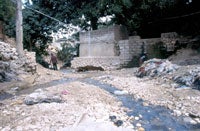 In Jamaica, support was provided to prepare a national policy and action plan for integrated vector control of malaria and for pilot studies in Kingston and Portmore to show how solid waste and partially treated wastewater contribute to the creation of mosquito breeding sites. The studies were followed up with advocacy for integrated vector control at the local level. In addition, the Organization prepared a concept paper on minimizing the use of pesticides that affect the environment and health and alternative biological methods that use plants with repellent and pesticide properties. The paper was submitted to the Ministry of Health and presented to the Environmental Health Fund, which is considering funding a related pilot project.
In Jamaica, support was provided to prepare a national policy and action plan for integrated vector control of malaria and for pilot studies in Kingston and Portmore to show how solid waste and partially treated wastewater contribute to the creation of mosquito breeding sites. The studies were followed up with advocacy for integrated vector control at the local level. In addition, the Organization prepared a concept paper on minimizing the use of pesticides that affect the environment and health and alternative biological methods that use plants with repellent and pesticide properties. The paper was submitted to the Ministry of Health and presented to the Environmental Health Fund, which is considering funding a related pilot project.
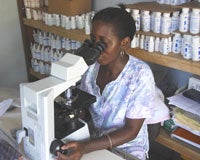 Guyana improved its regional health authorities’ capacities to control outbreaks through training for microscopists and the heads of malaria “mini-laboratories,” monitoring of resistance to anti-malarial treatments, and the establishment of two sentinel sites for monitoring of drug quality. A new operational manual for the management of malaria medicines and supplies was also developed.
Guyana improved its regional health authorities’ capacities to control outbreaks through training for microscopists and the heads of malaria “mini-laboratories,” monitoring of resistance to anti-malarial treatments, and the establishment of two sentinel sites for monitoring of drug quality. A new operational manual for the management of malaria medicines and supplies was also developed.
In Haiti, support was continued to the National Malaria Program and for the implementation of Haiti’s 2008 National Plan for Malaria Control. The Organization purchased malaria drugs and supplies for the program, including 20,000 pesticide-impregnated mosquito nets for hospitals in malaria-affected areas. It also worked with the National Public Health Laboratory to improve epidemiological, entomological, and parasitological surveillance.
Honduras implemented a malaria information and surveillance system and carried out a study on the management and availability of antimalarial drugs in the public and private sectors. In the Mosquitia region, the Organization supported the implementation of a plan for comprehensive malaria control in the municipality of Wampusirpi, Gracias a Dios, through a health survey, mass diagnosis and treatment, distribution of insecticide-treated bed nets, education of families, and entomological analysis.
The Organization’s Caribbean Epidemiology Center (CAREC) continued to monitor reports of malaria from its 23 member countries and territories. Just four countries reported indigenous cases during 2010-2011, 95 percent of them from Guyana. CAREC also monitored undifferentiated fever (UF), a proxy for infections including malaria, dengue, and leptospirosis, and issued alerts when the reported number of cases exceeded expected numbers. Additionally, CAREC provided training on outbreak investigation, hosted a workshop on data analysis for laboratory staff from eight countries and territories, and organized a meeting of national epidemiologists and laboratory directors to discuss data reporting and other surveillance and laboratory issues related to malaria.
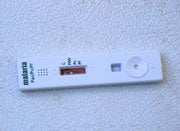 In non-endemic countries of the Caribbean, including the Bahamas and Turks and Caicos, PAHO/WHO supported the maintenance of surveillance capacities, procurement of rapid diagnostic test kits and medicines, and capacity-building in vector control and response.
In non-endemic countries of the Caribbean, including the Bahamas and Turks and Caicos, PAHO/WHO supported the maintenance of surveillance capacities, procurement of rapid diagnostic test kits and medicines, and capacity-building in vector control and response.
The fourth annual “Malaria Champions of the Americas” contest was held in 2010, with winning entries from Suriname, Brazil, and Colombia. The top winner was Suriname’s National Malaria Board, which oversees efforts that have virtually eliminated malaria from most of the country’s interior. The second honor went to Brazil’s Foundation for Health Surveillance of the Amazon for its efforts in integrated prevention and control of malaria in the state of Amazonas. Third place went to the Administrative Department of Health and Social Security of Chocó (DASALUD-Chocó) in Colombia, whose efforts have helped reduce the incidence of malaria in Chocó by more than half. The winners were honored at a celebration of the 2010 Malaria Day in the Americas at the PAHO/WHO Regional Office.
Tuberculosis
As highlighted in Chapter 1, the Americas as a whole have already begun to reverse the spread of TB, but progress among individual countries has been uneven. Technical cooperation in this area was provided within the framework of the Regional Strategy for the Control of Tuberculosis for 2005-2015 (CD46.R12), which seeks to advance MDG-6 by applying the WHO Stop-TB program. The strategy emphasizes expansion of directly observed treatment – short course (DOTS), measures to address TB drug resistance, and coordination of efforts to address co-infections with HIV and TB.
 Click here to find out more about Tuberculosis on the web
Click here to find out more about Tuberculosis on the web
Technical cooperation in this area focused on ensuring universal access for patients with TB/HIV co-infections to ART and preventive treatment, strengthening laboratory capacity by introducing rapid diagnostic tests for resistant TB, and improvements in inter-programmatic and community-based collaboration to address the social determinants of TB, particularly in poor and marginalized populations. Other support included the promotion of communication and social mobilization strategies to address stigma and discrimination of TB and to raise public and political awareness of the importance of combating TB.
 In Brazil, PAHO/WHO partnered with USAID to provide support for the National TB Program, including strengthening operational capacity, implementing recommendations from a 2009 PAHO/WHO-supported evaluation, and expanding the Stop TB strategy in 12 municipalities in Rio de Janeiro and in Manaus, Amazonas. The Organization also supported the advocacy and social mobilization efforts of the Brazilian Alliance to Stop TB, helped implement a distance-learning program on TB for health personnel at the state and municipal levels, and carried out a study of TB prevalence among people with diabetes in São Paulo and Bahia states.
In Brazil, PAHO/WHO partnered with USAID to provide support for the National TB Program, including strengthening operational capacity, implementing recommendations from a 2009 PAHO/WHO-supported evaluation, and expanding the Stop TB strategy in 12 municipalities in Rio de Janeiro and in Manaus, Amazonas. The Organization also supported the advocacy and social mobilization efforts of the Brazilian Alliance to Stop TB, helped implement a distance-learning program on TB for health personnel at the state and municipal levels, and carried out a study of TB prevalence among people with diabetes in São Paulo and Bahia states.
Ecuador’s efforts in this area included the development of a new project to strengthen TB control, with a focus on areas of high prevalence, and a plan to provide monthly bonuses to patients with MDR-TB to reduce the number of patients who stop taking medication. Ecuador also revised and improved its TB information system and strengthened its regulation of sales of anti-TB medications. In addition, PAHO/WHO supported the work of a technical mission from the University of Massachusetts to evaluate Ecuador’s network of diagnostic laboratories and to make recommendations for future technical cooperation in this area.
External evaluations of existing TB programs in Costa Rica and Colombia produced recommendations for strengthening human resources management and collaborative actions between HIV and TB programs, and for improving the management of childhood TB, DOTS implementation, and case follow-up.
Technical cooperation provided to the National TB Program of El Salvador helped the Ministry of Health submit a proposal that was approved during Round 9 of the Global Fund to Fight AIDS, Tuberculosis and Malaria.
In Haiti, the Organization supported the reconstruction of a TB sanatorium that was damaged in the 2010 earthquake and helped train its staff in the new WHO guidelines for treatment of TB. Additional support was provided for the National TB Program through a partnership with CDC, USAID, Family Health International, Grace Children’s Hospital, GHESKIO, and Partners in Health.
Mexico developed, produced, and distributed a new Guide for the Care of Persons with Drug-Resistant Tuberculosis in all 32 states to help standardize the management of resistant-TB patients throughout the country. The Ministry of Health of Honduras implemented a national system for information and monitoring of MDR-TB, with data on sex and age disaggregated by individual and locality.
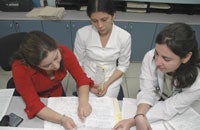 In Nicaragua, the Organization provided TB-related technical cooperation and support to the Ministry of Health in partnership with the medical faculties of the National Autonomous University of Nicaragua, the Ministry of Education, the Ministry of Interior, the Nicaraguan Social Security Institute, and the National Army’s Military Medical Corps. Specific activities included technical and financial support for the development and implementation of a new Protocol for Multidrug-Resistant TB and for funding proposals to the Global Fund to Fight AIDS, Tuberculosis and Malaria.
In Nicaragua, the Organization provided TB-related technical cooperation and support to the Ministry of Health in partnership with the medical faculties of the National Autonomous University of Nicaragua, the Ministry of Education, the Ministry of Interior, the Nicaraguan Social Security Institute, and the National Army’s Military Medical Corps. Specific activities included technical and financial support for the development and implementation of a new Protocol for Multidrug-Resistant TB and for funding proposals to the Global Fund to Fight AIDS, Tuberculosis and Malaria.
Technical cooperation to improve coordination of TB and HIV efforts was provided to a number of countries. Guyana rolled out a new IMAI program and strengthened implementation of DOTS to improve care for people with HIV/TB co-infections. Venezuela developed strategic plans to address TB/HIV co-infections through improved surveillance, increased coordination and joint action between TB and HIV programs at the national and regional levels, and implemented TB-HIV control interventions in penal institutions. In Nicaragua, PAHO/WHO monitored and supported TB-HIV collaborative activities aimed at preventing co-infections with TB/HIV.
In Suriname, the Organization provided support to the newly established National Laboratory with equipment and training and facilitated exchanges with other countries in the Region and CARICOM. CAREC continued to support TB surveillance efforts in Suriname and other member countries and facilitated standardized collection of data by the countries for submission to WHO’s Stop TB initiative.
On the U.S.-Mexico border, the Organization developed a community guide to treatment and prevention of TB and HIV in the border area and produced a technical report on TB and social determinants of health in the border states of Tamaulipas, Texas, Coahuila, Chihuahua, New Mexico, Sonora, Arizona, California and Baja California. The study examined rates of TB and MDR-TB in the 44 U.S. counties and 80 Mexican municipalities and included a comparative analysis of TB in 16 “sister cities.” The report was launched on World TB Day 2011.
Neglected Diseases
In addition to its support for efforts to fight HIV, TB, and malaria, the Organization helped advance MDG-6 through technical cooperation on neglected diseases, which continue to affect vulnerable communities throughout the Americas. The framework for this work includes the WHO Global Plan to Combat Neglected Tropical Diseases 2008-2015 and PAHO’s Elimination of Neglected Diseases and Other Poverty-Related Infections (CD49/9). During 2010-2011, PAHO/WHO’s activities in this area ranged from advocacy and consensus-building to support for surveillance and prevalence studies.
In 2010, the new regional Strategy and Plan of Action for Chagas Disease Prevention, Control, and Care was finalized and subsequently approved by PAHO’s 50th Directing Council (CD50.R17). The strategy urges an integrated approach to the prevention and control of Chagas and improved medical care for those suffering from the disease. It also calls for redoubling efforts to eliminate vector-borne transmission of the Chagas parasite, T. cruzi, by 2015 through interprogrammatic collaboration and intersectoral action that addresses the social determinants of the diseases.
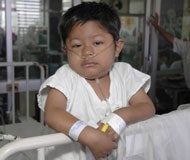 Jointly with the Sabin Vaccine Institute, the IDB, and the Global Network for Neglected Tropical Diseases, PAHO/WHO in 2011 published the advocacy report A Call to Action: Addressing Soil-transmitted Helminths in Latin America and the Caribbean, signed by the heads of all four organizations. It details the health and economic toll of parasitic intestinal worms (geohelminths) on at-risk populations, particularly children, and presents recommendations for action and policies to advance the elimination of these diseases as a public health problem by 2015. Its recommendations include creating a coalition against intestinal parasites in the Americas, involving first ladies as advocates of deworming, and supporting a new trust fund for neglected tropical diseases. With the same partners and with support from the Bill & Melinda Gates Foundation, PAHO/WHO continued work on the creation of the trust fund, which would mobilize resources for projects to control intestinal parasites and other neglected diseases.
Jointly with the Sabin Vaccine Institute, the IDB, and the Global Network for Neglected Tropical Diseases, PAHO/WHO in 2011 published the advocacy report A Call to Action: Addressing Soil-transmitted Helminths in Latin America and the Caribbean, signed by the heads of all four organizations. It details the health and economic toll of parasitic intestinal worms (geohelminths) on at-risk populations, particularly children, and presents recommendations for action and policies to advance the elimination of these diseases as a public health problem by 2015. Its recommendations include creating a coalition against intestinal parasites in the Americas, involving first ladies as advocates of deworming, and supporting a new trust fund for neglected tropical diseases. With the same partners and with support from the Bill & Melinda Gates Foundation, PAHO/WHO continued work on the creation of the trust fund, which would mobilize resources for projects to control intestinal parasites and other neglected diseases.
At the country level, the Organization helped develop integrated plans for the control of neglected diseases in Colombia, the Dominican Republic, El Salvador, Guyana, Haiti, and Honduras. Other technical cooperation included support for Colombia to eliminate trachoma and onchocerciasis and to control geohelminths; for Haiti to eliminate lymphatic filariasis and control geohelminths during the post-earthquake reconstruction phase; and for Guyana to implement a mass-medication strategy to eliminate lymphatic filariasis. In the Dominican Republic, the Organization supported a study of transmission of lymphatic filariasis and evaluated current efforts to eliminate that disease.
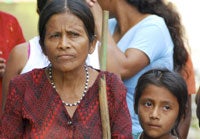 Technical cooperation was provided in Colombia, El Salvador, and Honduras to develop protocols for surveys of prevalence and intensity of geohelminth infections and in Suriname for a prevalence study of both geohelminths and schistosomiasis in school-age children. Bolivia developed a deworming program for preschool and school-age children to be incorporated into existing immunization and IMCI programs.
Technical cooperation was provided in Colombia, El Salvador, and Honduras to develop protocols for surveys of prevalence and intensity of geohelminth infections and in Suriname for a prevalence study of both geohelminths and schistosomiasis in school-age children. Bolivia developed a deworming program for preschool and school-age children to be incorporated into existing immunization and IMCI programs.
In the Dominican Republic, the Organization worked with six other UN agencies on a three-year program to benefit banana plantation workers and their families. In collaboration with the Ministry of Health, the Organization was responsible for health interventions aimed at preventing HIV/AIDS, malaria, cholera, leptospirosis, and other infectious diseases. The interventions included improvements in environmental conditions at hospitals in three provinces as well as community capacity-building for disease prevention. The program is being financed by Spain’s MDG Achievement Fund.
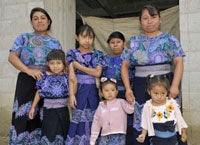 Jointly with the IDB, the Sabin Vaccine Institute, and the Global Network for Neglected Tropical Diseases, PAHO/WHO supported the development and implementation of two pilot projects for control of neglected diseases in Chiapas, Mexico, and Recife, Brazil.
Jointly with the IDB, the Sabin Vaccine Institute, and the Global Network for Neglected Tropical Diseases, PAHO/WHO supported the development and implementation of two pilot projects for control of neglected diseases in Chiapas, Mexico, and Recife, Brazil.
A number of publications on neglected diseases were produced in 2010-2011, including an article in the Public Library of Science (PLoS) journal Neglected Tropical Diseases arguing that several neglected diseases could be eliminated or reduced as public health problems through stepped-up implementation of existing plans and guidelines. The paper focuses on schistosomiasis, lymphatic filariasis, onchocerciasis, geohelminths, and rabies, and uses the results of a mapping and modeling exercise to highlight “major hotspots” where two or more of these diseases overlap.
A number of workshops and meetings were organized to advance efforts to eliminate neglected diseases. They included a workshop organized jointly with McGill University on integrating deworming into existing health programs for school-age children; the First Regional Meeting on the Elimination of Trachoma, in Bogota, Colombia; the 10th regional meeting of heads of programs to eliminate lymphatic filariasis, held in Georgetown, Guyana; and, in El Salvador, a regional training workshop on developing integrated plans for the prevention, control, and elimination of neglected diseases. Another workshop in El Salvador focused on using the Kato-Katz technique to determine prevalence of helminth infections.
MDG-7 Ensure Environmental Sustainability
 As discussed in Chapter 1, the countries of the Americas have significantly expanded access to drinking water and sanitation and have reduced gaps in access between urban and rural residents. Nonetheless, some 40 million people in the Region still lack access to improved sources of drinking water. Technical cooperation was provided to ensure progress not only toward the MDG-7 targets but also toward universal access to water and sanitation for the Region’s inhabitants.
As discussed in Chapter 1, the countries of the Americas have significantly expanded access to drinking water and sanitation and have reduced gaps in access between urban and rural residents. Nonetheless, some 40 million people in the Region still lack access to improved sources of drinking water. Technical cooperation was provided to ensure progress not only toward the MDG-7 targets but also toward universal access to water and sanitation for the Region’s inhabitants.
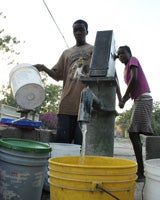 Much of the work in this area focused on water safety plans, which promote comprehensive risk assessment and risk management in all steps of water supply, from catchment to consumers. The Organization supported the development of evidence-based standards for regulatory purposes, the design of plans and programs for surveillance and monitoring of water quality, and capacity-building in ministries of health in these areas as well as in epidemiological surveillance of water-borne diseases.
Much of the work in this area focused on water safety plans, which promote comprehensive risk assessment and risk management in all steps of water supply, from catchment to consumers. The Organization supported the development of evidence-based standards for regulatory purposes, the design of plans and programs for surveillance and monitoring of water quality, and capacity-building in ministries of health in these areas as well as in epidemiological surveillance of water-borne diseases.
In Jamaica, technical cooperation was provided to improve drinking water and waste disposal as part of larger efforts to promote healthy housing and communities. This work included stakeholder consultations to promote compliance with water quality guidelines and water safety plans. The Organization also advocated with the Ministry of Local Government and the Ministry of Water and Housing for the extension of water and sanitation coverage to areas previously supplied with rain water catchments, showing the importance that water has on economic development and health. Jamaica implemented a database on water quality findings, updated its Cholera Outbreak Prevention and Control Operational Plan, and carried out a promotional campaign for the prevention of cholera.
 In Bolivia, the Organization supported efforts by Environmental Sanitation Units to monitor water sources for 13,000 homes in the departments of Cochabamba and Chuquisaca, as part of a larger program on food and nutritional security (see under MDG-1). As part of this project, portable water-quality testing instruments were provided to three health networks and “Aguamiga” water-quality kits to eight schools.
In Bolivia, the Organization supported efforts by Environmental Sanitation Units to monitor water sources for 13,000 homes in the departments of Cochabamba and Chuquisaca, as part of a larger program on food and nutritional security (see under MDG-1). As part of this project, portable water-quality testing instruments were provided to three health networks and “Aguamiga” water-quality kits to eight schools.
Brazil’s Ministry of Health updated national quality standards on water for human consumption and consolidated a system for water surveillance. This was done through a participatory process that allowed both water providers and consumers to make proposals and engage in debate over the new standards.
Ecuador prepared a national plan for surveillance of water quality and increased knowledge and capacity in water quality surveillance in 20 cantons in four provinces, which are home to some 2 million people. These efforts were part of a larger program on water and sanitation governance financed by Spain’s MDG Achievement Fund and carried out with support from PAHO/WHO, UNDP, the United Nations Human Settlements Program (UN-Habitat), and ILO.
Nicaragua prepared and presented legislative proposals including a National Water Law and a Law on Potable Water Committees, as well as a National Wastes Law, which is currently in process. The country also mobilized municipalities and environmental youth groups to implement policies and initiatives in the area of environmental health.
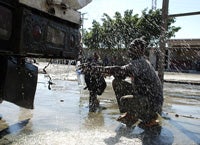 Continuous support was provided to safe water and sanitation efforts in post-earthquake Chile and Haiti and in Central America and the Dominican Republic for the development of a strategy for risk management in water and sanitation in case of disasters.
Continuous support was provided to safe water and sanitation efforts in post-earthquake Chile and Haiti and in Central America and the Dominican Republic for the development of a strategy for risk management in water and sanitation in case of disasters.
The Organization also worked with other UN agencies within the “Sanitation and Water for All” Global Framework for Action and supported the Global Annual Assessment of Sanitation and Drinking-Water (GLAAS), a WHO-led initiative to provide policymakers with evidence and analyses to make informed decisions in sanitation and drinking-water.
In addition, MDG-7 was advanced by promoting primary environmental care and healthy settings, including healthy housing, schools, and workplaces.
The Organization’s support for efforts to advance MDG-7 also included technical cooperation in the area of climate change. In Jamaica, this included the preparation of a national document on climate change and health, the establishment of a technical group on the subject, and joint sponsorship of several events with the Jamaican Meteorological Office and related professional organizations.
In addition, inter-agency efforts were advanced to prepare for the 20th United Nations Conference on Sustainable Development (Rio+20), to be held in Brazil in June 2012. A key topic at the conference will be the green economy in the context of eradicating poverty and promoting sustainable development.
MDG-8 Develop a Global Partnership for Development
 PAHO/WHO has historically been a catalyst for international partnerships to advance health and development in the Americas and has continued this leadership with respect to the MDGs. As noted in Chapter 1, the Organization is a participant in or a founding member of a number of important regional partnerships dedicated to accelerating progress on the MDGs. These include the Newborn Health Alliance for Latin America and the Caribbean, GTR, the Safe Motherhood Initiative, and PAND (these initiatives are described in more detail under MDG-4 and MDG-5 above).
PAHO/WHO has historically been a catalyst for international partnerships to advance health and development in the Americas and has continued this leadership with respect to the MDGs. As noted in Chapter 1, the Organization is a participant in or a founding member of a number of important regional partnerships dedicated to accelerating progress on the MDGs. These include the Newborn Health Alliance for Latin America and the Caribbean, GTR, the Safe Motherhood Initiative, and PAND (these initiatives are described in more detail under MDG-4 and MDG-5 above).
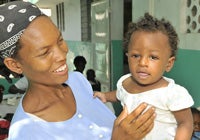 Another key regional alliance for advancing the MDGs is the UN Regional Directors Team (UNDG-LAC). Founded in 2003, UNDG-LAC brings together the regional heads of 20 UN agencies active in Latin America and the Caribbean. The group works to enhance the effectiveness of UN technical cooperation and aid at the country level by improving inter-agency collaboration, promoting country priorities, and creating synergies. PAHO’s Director worked closely with other regional directors in the group on issues including nutrition, maternal mortality, indigenous rights, and youth involvement in advancing the MDGs.
Another key regional alliance for advancing the MDGs is the UN Regional Directors Team (UNDG-LAC). Founded in 2003, UNDG-LAC brings together the regional heads of 20 UN agencies active in Latin America and the Caribbean. The group works to enhance the effectiveness of UN technical cooperation and aid at the country level by improving inter-agency collaboration, promoting country priorities, and creating synergies. PAHO’s Director worked closely with other regional directors in the group on issues including nutrition, maternal mortality, indigenous rights, and youth involvement in advancing the MDGs.
At the country level, the Organization also worked with other UN agencies under the Common Country Assessment/United Nations Development Assistance Framework (CCA/UNDAF), as a participant in the UN Country Teams and as an implementing agency for projects financed by multilateral trust funds including the MDG Achievement Fund (Spain), the UN Trust Fund for Human Security (Japan), the UN Trust Fund to Eliminate Violence against Women (multidonor), and the Rural Development Joint Program in Guatemala (Sweden).
PAHO/WHO also partnered with bilateral development agencies including AECID, CIDA, the Japan International Cooperation Agency (JICA), the Norwegian Agency for Development Cooperation (NORAD), PEPFAR, the Swedish International Development Cooperation Agency (SIDA), USAID, and CDC, which provided both funding and technical cooperation for projects and programs. In addition, joint projects, programs, and activities were carried out with a number of international NGOs, including the GAVI Alliance, Save the Children, Enfants du Monde, the Church of Jesus Christ of Latter-day Saints, the General Conference of Seventh-day Adventists, Partners in Health, and the Canadian Red Cross.
The Organization also worked with a wide range of domestic partners in its member countries, including professional, academic, community-based, charitable, faith-based, and other civil society organizations. All these partnerships were in addition to collaborations with national, departmental, and local government authorities from sectors including health, education, agriculture, development, environment, and women’s and indigenous affairs, in activities and projects that are described in more detail above.
Access to Medicines
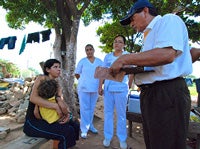 Technical cooperation in the area of essential medicines has helped Member States expand access to quality drugs and biological products while reducing out-of-pocket expenditures by individuals and families, especially the poor. This work ranged from support for the development, implementation, and monitoring of pharmaceutical policies to negotiation of lower drug prices and procurement of drugs and supplies on behalf of countries through the PAHO Strategic Fund.
Technical cooperation in the area of essential medicines has helped Member States expand access to quality drugs and biological products while reducing out-of-pocket expenditures by individuals and families, especially the poor. This work ranged from support for the development, implementation, and monitoring of pharmaceutical policies to negotiation of lower drug prices and procurement of drugs and supplies on behalf of countries through the PAHO Strategic Fund.
The framework for actions in this area includes the third WHO Medicines Strategy (2008-2013), Essential Public Health Functions (CD42.R14, 2000), Access to Medicines (CD45.R7, 2004), the WHO Global Strategy and Plan of Action on Public Health, Innovation and Intellectual Property (WHA61.21, 2008), and its regional counterpart, Public Health, Innovation, and Intellectual Property: A Regional Perspective (CD48.R15, 2008).
An important addition to this framework was the new strategy Strengthening National Regulatory Authorities for Medicines and Biologicals (CD50.R9), which was finalized during 2010 and approved by PAHO’s 50th Directing Council. It seeks to improve the abilities of national regulatory authorities to guarantee the quality, safety, and efficacy of pharmaceutical products through such functions as authorizing clinical trials and approving products for market, inspection and licensing of manufacturers and distributors, and oversight of advertising and the rational use of medicines. To support these efforts, the national regulatory authorities of Argentina, Brazil, Colombia, and Cuba were identified as regional references.
The Organization also developed a new strategy on the use of generic medicines to improve access to and the rational use of medicines. A draft was web-published for review by stakeholders in late 2010, and the resulting feedback was incorporated into the final version, which was launched at the 6th Pan American Conference on Drug Regulatory Harmonization (CPANDRH) in Brasilia (see also below).
 Another important area of work was the promotion of health research and development that better address public health needs in the countries, including R&D on neglected diseases and diseases of poverty. In 2010, Innovation for Public Health in the Americas: Promotion of Research and Development of Health Products was published based on the conclusions of a 2009 conference organized jointly by PAHO/WHO and the Special Program for Research and Training in Tropical Diseases (TDR). The report includes recommendations on how to create systems for innovation at the national, subregional, and regional levels to promote affordable and appropriate health products that address the health priorities of PAHO/WHO member countries.
Another important area of work was the promotion of health research and development that better address public health needs in the countries, including R&D on neglected diseases and diseases of poverty. In 2010, Innovation for Public Health in the Americas: Promotion of Research and Development of Health Products was published based on the conclusions of a 2009 conference organized jointly by PAHO/WHO and the Special Program for Research and Training in Tropical Diseases (TDR). The report includes recommendations on how to create systems for innovation at the national, subregional, and regional levels to promote affordable and appropriate health products that address the health priorities of PAHO/WHO member countries.
The Organization also continued developing a new Regional Platform for Access and Innovation for Health Technologies, a series of internet-based tools that allow stakeholders from different sectors to interact in ways that promote access, rational use, and good governance in the area of essential medicines and other health technologies. PAHO/WHO presented a proposal and received feedback on the platform from health and regulatory authorities, academicians and researchers, science and technology authorities, and representatives of the manufacturing sector. Partners in the project include INFOMED Cuba and BIREME; support is being provided by the United States Food and Drug Administration (FDA), the European Union (through TDR), Brazil, and Spain.
The Pan American Network for Drug Regulatory Harmonization (PANDRH) organized the 6th Pan American Conference on Drug Regulatory Harmonization (CPANDRH) in Brasilia in July 2011. The conference drew more than 300 participants from 26 countries, including health authorities, experts on regulatory and related issues, and representatives of the pharmaceutical industry. PANDRH working groups on good laboratory practices, biotechnology products, drug registration, and counterfeit drugs presented the results of their recent collaborative work.
On World Health Day 2011, which was devoted to the issue of antimicrobial resistance, PAHO/WHO hosted a special panel discussion moderated by CNN in Spanish’s weekend news anchor, Claudia Palacios, and featuring experts including Dr. Anthony Fauci, Director of the U.S. National Institute of Allergy and Infectious Diseases; Dr. Marcelo Galas, of the Ministry of Health of Argentina; Dr. Susan Foster, of the Alliance for the Prudent Use of Antibiotics; and PAHO Deputy Director Jon Andrus. The event called attention to problems such as multidrug-resistant hospital- and community-acquired infections; growing resistance to drugs for TB, malaria, and HIV; the use of antibiotics in livestock production; and patient and health-provider practices that contribute to antimicrobial resistance.
 Click here to find out more about World Health Day on the web
Click here to find out more about World Health Day on the web
Faces, Voices, and Places of the MDGs
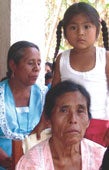 While nearly all PAHO/WHO technical cooperation contributes to progress toward the MDGs, the Faces, Voices, and Places (FVP) initiative has become the Organization’s flagship effort to advance the MDG agenda in communities that need it most.
Launched in 2006, the multisector initiative works in vulnerable communities through partnerships with local leaders as well as nongovernmental and grassroots organizations, with the aim of raising awareness about the MDGs and promoting community participation and empowerment.
While nearly all PAHO/WHO technical cooperation contributes to progress toward the MDGs, the Faces, Voices, and Places (FVP) initiative has become the Organization’s flagship effort to advance the MDG agenda in communities that need it most.
Launched in 2006, the multisector initiative works in vulnerable communities through partnerships with local leaders as well as nongovernmental and grassroots organizations, with the aim of raising awareness about the MDGs and promoting community participation and empowerment.
FVP departs from the premise that national-level indicators can hide extreme poverty and social exclusion that continue to affect many communities, particularly in middle-income countries, where 90 percent of the poor live. FVP addresses this problem by working in vulnerable communities throughout Latin America and the Caribbean, using the social determinants of health as a point of departure. As of 2010-2011, more than 40 communities in 23 countries were participating in FVP.
 Click here to find out more about Faces, Voices, and Places of the MDGs on the web
Click here to find out more about Faces, Voices, and Places of the MDGs on the web
The initiative uses participatory strategies and integrated interventions to empower communities to overcome the social determinants that have kept them in poverty and that prevent them from achieving the MDGs. It promotes horizontal communication and information exchange between technical cooperation providers and beneficiaries to ensure that interventions address problems and priorities identified by the communities themselves and also that those solutions are sustainable over time.
In Bolivia, FVP is being implemented in Cuarirenda, Santa Cruz, which is a Guarani community of fewer than 500 residents. Through a participatory diagnostic exercise, community members identified their priorities as producing sufficient food to meet each family's nutritional needs; empowering women; expanding the local health post to have a delivery room and offer HPV screening; training community members on how to prevent common illnesses such as Chagas disease; and improving water and sanitation services by constructing a new well, improving latrines, and recycling trash.
In the Cuban communities of Cotorro, La Habana, and Santa Isabel de las Lajas, Cienfuegos, FVP is benefiting primarily children at risk of neuro-developmental disorders, pregnant teens, and older adults, using an approach that mobilizes and empowers the community to address these groups’ special needs.
In the Dominican Republic, the initiative is working in communities with high levels of malnutrition, poor environmental sanitation, and a significant presence of Haitian refugees. In coordination with the Ministry of Health, FVP has provided training for community members in nutrition, malaria, dengue, cholera, and leptospirosis, as well as latrine construction.
Starting in 2010, FVP began expanding autonomously into communities and municipalities near those already participating in the initiative. Participating mayors in Panama invited leaders from 11 new municipalities to join the initiative during 2010, and in 2011 extended a similar invitation to leaders of indigenous communities. In Costa Rica, FVP has spread throughout Brunca, the country’s poorest region. In South America’s Chaco region, mayors from communities in Argentina, Bolivia, and Paraguay pledged to promote the initiative in other communities through a TCC project.
In rural Olinda and Guarulhos, Brazil, participating mayors have created their own mayors’ network and invited other mayors from surrounding communities to their annual meetings. In 2011, Brazil’s Ministry of Health formally recognized FVP as a health program and provided it with official health sector financing. Brazil’s National Council of Municipal Health Departments (CONASEMS) also pledged its support.
FVP was launched for the first time in the English-speaking Caribbean during 2010-2011, thanks to the work of members of the Young Professionals for the MDGs program (a joint initiative of PAHO/WHO and several U.S. and Canadian universities). Participants include members of the Carib tribe in Dominica and vulnerable communities in Anguilla, Grenada, and Montserrat.
Based on its experiences in 23 countries, FVP has developed a Virtual Basket of Best Practices at the community level for advancing each of the MDGs. Four key elements have proven essential for successful and sustainable implementation of the initiative: the committed participation of mayors and other local authorities, the creation of a core group of community leaders who can provide direction and momentum, the involvement of an academic institution as an implementing partner, and community empowerment through capacity-building. PAHO/WHO is promoting the latter through an educational program in “Health and Local Development,” which has graduated 162 community actors from 23 countries since 2009.
 Go to next Chapter
Go to next Chapter
1 GTR members include PAHO/WHO, UNICEF, UNFPA, UNIFEM, UNOPS, UNESCO, ECLAC, USAID, Family Care International, the Population Council, the Inter-American Development Bank (IDB), the International Federation of Gynecology and Obstetrics (FIGO) and its Latin American arm FLASOG, and the International Confederation of Midwives (ICM). Associate members include UNHCR, UNDP, ILO, UNEP, UNAIDS, OCHA, FAO, UNHCHR, and the World Bank. Funding is provided by members and the Spanish Agency for International Development Cooperation (AECID).
 As indicated in Chapter 1, more than half of Latin American and Caribbean countries and territories appear to be on track at the national level to achieve the official MDG targets for hunger. Yet progress varies across and within countries. Moreover, acute malnutrition has re-emerged as a problem in several countries, and scant reductions have been achieved in micronutrient deficiencies.
As indicated in Chapter 1, more than half of Latin American and Caribbean countries and territories appear to be on track at the national level to achieve the official MDG targets for hunger. Yet progress varies across and within countries. Moreover, acute malnutrition has re-emerged as a problem in several countries, and scant reductions have been achieved in micronutrient deficiencies.
 Since 2006, PAHO/WHO has provided technical cooperation in this area within the framework of the Regional Strategy and Plan of Action on Nutrition in Health and Development 2006-2015 (CD47.R8, 2006), the Global Strategy for Infant and Young Child Feeding (WHO/UNICEF, 2003), and the International Code of Marketing of Breast-milk Substitutes (WHO, 1981). In 2010, PAHO’s 50th Directing Council approved the Strategy and Plan of Action for the Reduction of Chronic Malnutrition (CD50.R11), with the intent of strengthening activities proposed in the 2006 regional strategy through an integrated, intersectoral approach that addresses the social determinants of chronic malnutrition and incorporates proven interventions into primary health care. PAHO/WHO promoted this new strategy throughout 2010-2011 and supported its implementation in nine member countries: Belize, the Dominican Republic, El Salvador, Guatemala, Honduras, Nicaragua, Panama, Paraguay, and Peru.
Since 2006, PAHO/WHO has provided technical cooperation in this area within the framework of the Regional Strategy and Plan of Action on Nutrition in Health and Development 2006-2015 (CD47.R8, 2006), the Global Strategy for Infant and Young Child Feeding (WHO/UNICEF, 2003), and the International Code of Marketing of Breast-milk Substitutes (WHO, 1981). In 2010, PAHO’s 50th Directing Council approved the Strategy and Plan of Action for the Reduction of Chronic Malnutrition (CD50.R11), with the intent of strengthening activities proposed in the 2006 regional strategy through an integrated, intersectoral approach that addresses the social determinants of chronic malnutrition and incorporates proven interventions into primary health care. PAHO/WHO promoted this new strategy throughout 2010-2011 and supported its implementation in nine member countries: Belize, the Dominican Republic, El Salvador, Guatemala, Honduras, Nicaragua, Panama, Paraguay, and Peru.
One of the key elements of the new strategy is its endorsement of the Pan American Alliance for Nutrition and Development (PAND). Established in 2008 by the UN Regional Directors Team (UNDG-LAC), PAND facilitates inter-agency cooperation on evidence-based, interprogrammatic, and multisector interventions to tackle the multiple causes of malnutrition.
|
PAHO/WHO supported two major nutrition initiatives during 2010-2011 that exemplify the multisector, multi-agency approach promoted by PAND. Both initiatives were financed by Spain’s MDG Achievement Fund and contributed to advancing MDG-1 as well as MDG-4. The first, in Bolivia, is a three-year (2010-2012) program involving nine government ministries, 22 municipal governments, and six UN agencies, including PAHO/WHO. It seeks to build local capacity for food security and nutrition in the departments of Cochabamba and Chuquisaca and supports the country’s multisector Zero Malnutrition program. Beneficiaries include some 321,000 families living in 360 communities. The program works with community organizations, women’s groups, students and teachers, volunteer health aides, health workers, and local authorities, with interventions focused on health education for pregnant women, promotion of complementary feeding for nursing infants, and integrated management of childhood diseases for children under age 5 (IMCI strategy). It also includes measures to increase food self-sufficiency and improve water sources and sanitation. Since its launch in 2010, the program has trained nearly 1,000 women leaders on best practices in health, nutrition, and food safety and some 730 community health aides on the 10 nutrition-related Key Practices of Family and Community IMCI. The community health aides provide health and nutrition education for about 11,000 families; they also monitor their health and nutrition status and refer those who need attention to the proper health facilities. The program also has provided training in health and nutrition for 600 primary school teachers and includes a “healthy schools” component that mobilizes students and teachers to help ensure safe drinking water in schools. These efforts, together with monitoring of water sources by departmental Environmental Sanitation Units, are aimed at reducing the incidence of diarrheal diseases. The second initiative, in El Salvador, supports the implementation of a new national policy on food and nutritional security and included the roll-out of the National Council on Food and Nutritional Security (CONASAN). During 2010-2011, PAHO/WHO provided support for the program at the national level by helping update information on the food and nutrition situation in El Salvador and through technical cooperation on micronutrient fortification of foods (vitamin A, iron, folic acid, and B complex). In addition, the Organization supported the Regional Forum on Food and Nutritional Security (FOROSAN), whose members include the Center for Breastfeeding Support (CALMA), the National Center for Agricultural and Forestry Technology (CENTA), the Universidad del Oriente (UNIVO), the UN Food and Agriculture Organization (FAO), and the INTERVIDA Foundation. At the municipal level, support was provided to inter-institutional planning boards led by mayors and including representatives of the Ministry of Health, local schools, NGOs, and churches. To facilitate joint analysis and planning by the boards, PAHO/WHO helped carry out a baseline study of the prevalence of global, acute, and chronic malnutrition and anemia among boys and girls under 5 years old in the three municipalities. PAHO/WHO also helped train and equip 14 new Community-based Family Health Teams (ECOs), responsible for monitoring and providing primary healthcare services for 600 families each, as well as three additional ECOs that provide more specialized pediatric, gynecological, psychological, and surgical care. These efforts are coordinated by CONASAN and supported by El Salvador’s Ministries of Health, Education, and Agriculture, the Secretariat for Social Inclusion, the Technical Secretariat of the Presidency, UNIVO, and other UN agencies including UNICEF, WFP, FAO, and UNDP. |
 To promote the PAND approach elsewhere in the Region, PAHO/WHO organized meetings with health and other government authorities, civil society organizations, and international NGOs in countries including Argentina, Bolivia, Guatemala, Panama, Paraguay, and Peru.
To promote the PAND approach elsewhere in the Region, PAHO/WHO organized meetings with health and other government authorities, civil society organizations, and international NGOs in countries including Argentina, Bolivia, Guatemala, Panama, Paraguay, and Peru.
A number of other initiatives on food and nutritional security and child malnutrition were also supported. These included micronutrient supplementation and food fortification in 11 countries (Belize, Costa Rica, the Dominican Republic, Ecuador, El Salvador, Guatemala, Honduras, Nicaragua, Panama, and Peru), the construction of a national database of children suffering from acute malnutrition in Guatemala, and a national survey of target populations in Nicaragua.
 The Caribbean Food and Nutrition Institute (CFNI) developed and promoted a new Regional Protocol for the Detection, Prevention, and Treatment of Anemia in Maternal and Child Health Clinics in the Caribbean. It takes into account the high prevalence of anemia in some countries of the subregion as well as current programs, recent research, and international recommendations on anemia in pregnant women and young children in the maternal and child health clinical setting. The protocol emphasizes screening, supplementation, and the use of iron-rich and fortified foods as well as public health measures such as control of malarial and other parasites. It includes procedures for diagnosis and assessment as well as detection, prevention, and management of anemia at various life stages, particularly vulnerable periods such as pregnancy, post-partum, infancy, and early childhood.
The Caribbean Food and Nutrition Institute (CFNI) developed and promoted a new Regional Protocol for the Detection, Prevention, and Treatment of Anemia in Maternal and Child Health Clinics in the Caribbean. It takes into account the high prevalence of anemia in some countries of the subregion as well as current programs, recent research, and international recommendations on anemia in pregnant women and young children in the maternal and child health clinical setting. The protocol emphasizes screening, supplementation, and the use of iron-rich and fortified foods as well as public health measures such as control of malarial and other parasites. It includes procedures for diagnosis and assessment as well as detection, prevention, and management of anemia at various life stages, particularly vulnerable periods such as pregnancy, post-partum, infancy, and early childhood.
 In Cuba, the focus was on strengthening surveillance, prevention, and care of pregnant women and children under 5 with anemia and the design of a nutritional surveillance of anemia component for the country’s Maternal-Child Health Observatories. In Bolivia, the Organization supported a program to detect and treat anemia in pregnant women, nursing babies, children under 5, and school-age children. Technical cooperation was also provided to incorporate anemia prevention into Haiti’s Free Obstetric Care (SOG) program.
In Cuba, the focus was on strengthening surveillance, prevention, and care of pregnant women and children under 5 with anemia and the design of a nutritional surveillance of anemia component for the country’s Maternal-Child Health Observatories. In Bolivia, the Organization supported a program to detect and treat anemia in pregnant women, nursing babies, children under 5, and school-age children. Technical cooperation was also provided to incorporate anemia prevention into Haiti’s Free Obstetric Care (SOG) program.
A number of efforts took place to advance MDG-1 within the framework of the Faces, Voices, and Places (FVP) initiative. In Brazil’s countryside, for example, it helped revitalize the Association of Producers of Olinda-Amparo and implement a program to cultivate medicinal plants. FVP also supported the country’s Health in Schools Program with nutritional evaluations and orientation for children and teens in 20 schools.
In the El Chaco region of Argentina, Bolivia, and Paraguay, FVP supported training for small farmers and livestock producers; organized women producers of fruits and vegetables, bread, and crafts; and promoted food gardens in schools to improve child nutrition.
In Cuba, the Institute of Veterinary Medicine and local authorities implemented a “productive municipalities” strategy aimed at improving food and nutritional security. The strategy, implemented on a pilot basis in four municipal districts, supports families engaged in farming and animal husbandry and includes a new model for providing veterinary care.
|
The Caribbean Food and Nutrition Institute (CFNI), PAHO/WHO’s technical center in Jamaica, has established a small grants program that advances food and nutrition security while reducing poverty among members of vulnerable groups. It recognizes the links between poverty, nutrition, and health and empowers low-income people to overcome the conditions that lead to and prolong poverty through productive activities. During 2010, the program made grants of US$10,000 to $12,000 to six community-based groups in St. Kitts and Nevis to support income-generating projects that primarily benefit former sugar workers who were displaced following the closure of the country’s sugar industry in 2005. The projects included a 90-acre peanut plantation, broiler hen and rabbit meat producers, a small agro-processor, and a revolving fund for the purchase of new equipment for sustainable fishing to replace older fishing equipment. In addition to grants, the program provides training and technical assistance, facilitates membership arrangements and collective investment funds, and promotes networking and information sharing among the beneficiaries. |
 Other nutrition-related technical cooperation included evaluations by CFNI of school feeding programs in Jamaica, St. Vincent and the Grenadines, and Trinidad and Tobago and technical assistance to develop and publish food service manuals and cycle menus for use in schools. In addition, the Organization provided support for breastfeeding promotion, “baby-friendly hospitals,” and the new WHO Child Growth Standards, described in more detail under MDG-4 below.
Other nutrition-related technical cooperation included evaluations by CFNI of school feeding programs in Jamaica, St. Vincent and the Grenadines, and Trinidad and Tobago and technical assistance to develop and publish food service manuals and cycle menus for use in schools. In addition, the Organization provided support for breastfeeding promotion, “baby-friendly hospitals,” and the new WHO Child Growth Standards, described in more detail under MDG-4 below.
MDG-3 Promote Gender Equality and Empower Women
Gender remains a key social determinant in the Americas, not only of socioeconomic inequality but also of health status and prospects. PAHO/WHO work in this area seeks to increase gender equality in health as a matter of social justice but also addresses the differences between the health needs and risks of men and women, boys and girls to improve the coverage, effectiveness, efficiency, and impact of health interventions.
 The framework for technical cooperation in this area is the 2005 PAHO Gender Equality Policy (CD46/12) and the 2009 Regional Plan of Action for Implementing the Gender Equality Policy. These guide PAHO/WHO’s technical cooperation in its member countries as well as its own human resources management, strategic planning, monitoring, and evaluation.
The framework for technical cooperation in this area is the 2005 PAHO Gender Equality Policy (CD46/12) and the 2009 Regional Plan of Action for Implementing the Gender Equality Policy. These guide PAHO/WHO’s technical cooperation in its member countries as well as its own human resources management, strategic planning, monitoring, and evaluation.
The Organization supported the development and implementation of gender equality plans in Bolivia, Guatemala, Nicaragua, Paraguay, and Suriname. Letters of agreement were signed with the Council of Ministers for Women in Central America (COMMCA) and the Council of Ministers of Health of Central America (COMISCA) to mainstream gender in the Central American Integration System (SICA).
In the Andean Region, a participatory process for defining key indicators on gender and health led to a proposal to include them as part of the social indicators used by the Andean Community.
 In Nicaragua, the Organization supported the design and initial implementation of a project on gender and chronic disease that addresses the legal and social barriers to girls’ participation in sports and physical activity, to improve their well-being and decrease their risks for obesity and chronic disease.
In Nicaragua, the Organization supported the design and initial implementation of a project on gender and chronic disease that addresses the legal and social barriers to girls’ participation in sports and physical activity, to improve their well-being and decrease their risks for obesity and chronic disease.
In other technical cooperation in this area, gender-equality guidelines were used to review a proposal to the Global Fund by RedTransSex, a South American network of sex workers, and a proposal and interview guide to study gender aspects of multidrug resistant TB (MDR-TB) were finalized in Peru.
 The Organization collaborated on several publications in this area that were launched during 2010-2011, including Profile on Gender and Health in the Andean Subregion, Profile on Gender and Health for the Republic of Panama, Health of Men and Women in Central America and the Dominican Republic, and a statistical brochure on gender, health, and development in Costa Rica. In addition, the Organization launched a new virtual course on gender and health with a focus on human rights and cultural diversity, which is now available through the Virtual Public Health Campus.
The Organization collaborated on several publications in this area that were launched during 2010-2011, including Profile on Gender and Health in the Andean Subregion, Profile on Gender and Health for the Republic of Panama, Health of Men and Women in Central America and the Dominican Republic, and a statistical brochure on gender, health, and development in Costa Rica. In addition, the Organization launched a new virtual course on gender and health with a focus on human rights and cultural diversity, which is now available through the Virtual Public Health Campus.
In March 2011, during an event marking International Women’s Day, PAHO/WHO honored the winners of the 4th annual “Best Practices that Incorporate the Perspective of Gender Equality in Health” contest, which focused on HIV prevention, care, and treatment. The winners were an Argentine initiative that promotes sexual and reproductive health and prevention of HIV in adolescents from marginal neighborhoods, and an initiative from Trinidad and Tobago that provides counseling and treatment for couples with only one member who is HIV-positive.
 As part of its Gender, Diversity, and Human Rights program, the Organization also promoted the health and human rights of indigenous peoples. This work included technical support for the Andean Intercultural Plan on Indigenous Health and the Andean Intercultural Plan on Afro-descendants, as well as a technical cooperation between countries (TCC) project between Colombia and Brazil to promote health among the Rom people.
As part of its Gender, Diversity, and Human Rights program, the Organization also promoted the health and human rights of indigenous peoples. This work included technical support for the Andean Intercultural Plan on Indigenous Health and the Andean Intercultural Plan on Afro-descendants, as well as a technical cooperation between countries (TCC) project between Colombia and Brazil to promote health among the Rom people.
In coordination with ECLAC’s Latin American and Caribbean Demographic Center (CELADE) and UNFPA, PAHO/WHO collaborated with experts on indigenous and Afro-descendant affairs from ministries of health and civil society to develop a first draft of a recommendation to include ethnic/racial identification into health statistics, based on experiences in the Americas.
In May 2011, the Organization chaired the Inter-Agency Support Group on Indigenous Peoples’ Issues during the 10th session of the UN Permanent Forum on Indigenous Issues in New York and helped organize a side event on noncommunicable diseases in indigenous communities.
A new CD and a written guide to the United Nations Declaration on the Rights of Indigenous Peoples and ILO Convention 169 for civil society organizations, governments, UN agencies, and other stakeholders were also launched.
MDG-4 Reduce Child Mortality
 As noted in Chapter 1, Latin America and the Caribbean have the lowest infant mortality of any developing region as well as the fastest rate of decline in this indicator since 1990. But while the Region as a whole is on track to achieve MDG-4, progress has been uneven across and within countries. Technical cooperation in this area focused on consolidating gains already achieved and accelerating progress in countries and population groups that are lagging behind.
As noted in Chapter 1, Latin America and the Caribbean have the lowest infant mortality of any developing region as well as the fastest rate of decline in this indicator since 1990. But while the Region as a whole is on track to achieve MDG-4, progress has been uneven across and within countries. Technical cooperation in this area focused on consolidating gains already achieved and accelerating progress in countries and population groups that are lagging behind.
 Much of the work in this area is aimed at reducing neonatal mortality, that is, deaths within the first 28 days of life, which currently accounts for some 60 percent of mortality among children under 1 in the Region. The Regional Strategy and Plan of Action for Neonatal Health within the Continuum of Maternal, Newborn, and Child Care (CD48/7), approved in 2008 by PAHO’s 48th Directing Council, addresses care throughout the life cycle, including adolescence, preconception, pregnancy, childbirth, and childhood, not only in health clinics and hospitals but also in the home and the community.
Much of the work in this area is aimed at reducing neonatal mortality, that is, deaths within the first 28 days of life, which currently accounts for some 60 percent of mortality among children under 1 in the Region. The Regional Strategy and Plan of Action for Neonatal Health within the Continuum of Maternal, Newborn, and Child Care (CD48/7), approved in 2008 by PAHO’s 48th Directing Council, addresses care throughout the life cycle, including adolescence, preconception, pregnancy, childbirth, and childhood, not only in health clinics and hospitals but also in the home and the community.
A central focus of the strategy is care provided during the critical hours after childbirth, when a baby’s survival depends in large part on the skilled attendant who cares for both mother and child. The action plan stresses well-known cost-effective interventions, including IMCI interventions, as well as investments to strengthen health systems, with special attention to training and deployment of health professionals, including doctors, midwives, and nurses.
 Based on the regional strategy, technical cooperation to member countries sought to develop and implement neonatal health plans. In Brazil, Bolivia, the Dominican Republic, El Salvador, Guatemala, Honduras, Nicaragua, and Peru, the Organization helped incorporate evidenced-based neonatal interventions into norms and procedures for maternal and child care. In Guyana, it helped implement a course on “Essential Care of the Newborn” and developed a neonatal nursing care curriculum as part of the Magnet Hospital project.
Based on the regional strategy, technical cooperation to member countries sought to develop and implement neonatal health plans. In Brazil, Bolivia, the Dominican Republic, El Salvador, Guatemala, Honduras, Nicaragua, and Peru, the Organization helped incorporate evidenced-based neonatal interventions into norms and procedures for maternal and child care. In Guyana, it helped implement a course on “Essential Care of the Newborn” and developed a neonatal nursing care curriculum as part of the Magnet Hospital project.
A WHO-recommended methodology was used in the development of neonatal and child health profiles for six countries: Ecuador, the Dominican Republic, Guatemala, Honduras, Nicaragua, and Panama. The profiles utilized data disaggregated by geographical area (departments or provinces and municipalities) to provide a baseline for monitoring MDG progress and for planning and prioritizing activities and investments aimed at reducing neonatal, infant, child, and maternal mortality at the subnational and local levels.
A regional training module on monitoring, supervision, and evaluation of neonatal health in hospitals and other health facilities was developed, with six countries currently using the instrument to improve neonatal services: Bolivia, the Dominican Republic, Ecuador, Guatemala, Nicaragua, and Panama.
|
PAHO/WHO provided technical cooperation during 2010-2011 to help member countries improve the quality and timeliness of the data they generate to monitor progress toward achieving the MDGs. A special emphasis of this work has been updating time series data on infant and maternal mortality within the regional Basic Indicators, which includes data from all 48 countries and territories in the Americas. As of mid-2011, most countries had updated their time series data for indicators of MDGs 4 and 5. CLAP/WR has used this data to identify vulnerable women and children and to develop focused interventions for advancing MDGs 4 and 5. To disseminate the data further, a virtual space was created within the Regional Observatory of Health, where visitors can discuss the MDG indicators and exchange analytical approaches. The Eastern Caribbean Countries (ECC) office in Barbados hosted a workshop in which health officials from Anguilla, Antigua and Barbuda, Barbados, the British Virgin Islands, Dominica, Grenada, Montserrat, St. Lucia, St. Vincent and the Grenadines, and St. Kitts and Nevis reviewed their own time series data for MDGs 4, 5, and 6 and learned how to critically evaluate the quality of health information. As a result of the workshop, nine participating countries—Anguilla, Antigua and Barbuda, Barbados, Dominica, Grenada, Montserrat, St Lucia, St Vincent and the Grenadines, and St Kitts and Nevis—have carried out evaluations of their health information systems using tools from the Health Metrics Network (Red Métrica de Salud) and PRISM (Performance of Routine Information System Management). |
 At the regional level, the Organization strengthened coordination with other agencies working on child health through monthly meetings of the Latin America and Caribbean Newborn Health Alliance, whose members also include UNICEF, USAID, Save the Children, Plan International, the CORE Group, the Latin American Pediatrics Association (ALAPE), the Pan American Federation of Nursing Professionals (FEPPEN), and the Latin American Federation of Obstetrics and Gynecology Societies (FLASOG).
At the regional level, the Organization strengthened coordination with other agencies working on child health through monthly meetings of the Latin America and Caribbean Newborn Health Alliance, whose members also include UNICEF, USAID, Save the Children, Plan International, the CORE Group, the Latin American Pediatrics Association (ALAPE), the Pan American Federation of Nursing Professionals (FEPPEN), and the Latin American Federation of Obstetrics and Gynecology Societies (FLASOG).
To better coordinate child health efforts among different international agencies, academic institutions, and NGOs working in the same country, the Organization helped establish “national inter-agency alliances” for child health in six countries: Bolivia, the Dominican Republic, El Salvador, Guatemala, Nicaragua, and Peru. Similar alliances are expected to be established in another six countries by the end of 2011: Colombia, Ecuador, Guyana, Honduras, Panama, and Paraguay.
|
Guatemala is one of a dozen countries where inter-agency alliances to improve child health and survival were established. The framework for the alliance’s work is the IMCI strategy. The Organization and other alliance members—including the Ministry of Public Health, UNICEF, Save the Children, ILO, USAID, and the Church of Jesus Christ of Latter-day Saints—supported a number of activities during 2010-2011to implement IMCI in Guatemala’s public health system. The contributions in this area included support for the development of a National Strategy and Plan on Neonatal Health, training for health workers and managers, acquisition of pediatric medical equipment, and the adaptation of IMCI guidelines and manuals for the Guatemalan context. The latter covered areas including evidence-based neonatal interventions, monitoring of early child development, protocols for prevention and treatment of child abuse, and IMCI in the contexts of nursing, nutrition, pandemic influenza, and HIV care. |
An important focus of IMCI-related technical cooperation was monitoring of early child development as part of routine primary health care. PAHO/WHO developed a generic regional instrument that was being used in eight countries: Argentina, Brazil, Chile, the Dominican Republic, Guatemala, Nicaragua, Paraguay, and Peru.
 The Organization also promoted the incorporation of IMCI into pediatrics curricula in medical schools, with a focus on students in their final year, who typically are required to serve for several months in rural or vulnerable communities. At least nine countries were using IMCI in medical education: Argentina, Brazil, Bolivia, the Dominican Republic, Ecuador, Guatemala, Nicaragua, Peru, and Uruguay.
The Organization also promoted the incorporation of IMCI into pediatrics curricula in medical schools, with a focus on students in their final year, who typically are required to serve for several months in rural or vulnerable communities. At least nine countries were using IMCI in medical education: Argentina, Brazil, Bolivia, the Dominican Republic, Ecuador, Guatemala, Nicaragua, Peru, and Uruguay.
Similarly, IMCI content was incorporated into nursing curricula in 10 countries: Argentina, Chile, Cuba, the Dominican Republic, El Salvador, Guatemala, Nicaragua, Panama, Peru, and Uruguay.
In addition, distance-learning tools were disseminated to allow countries to train larger numbers of health personnel in evidence-based interventions.
 Efforts in the area of nutrition also contributed to improving child health, including the promotion of the WHO Child Growth Standards and the introduction of measurement of height in a number of countries that previously did not use this indicator. Colombia, Ecuador, Haiti, Honduras, Nicaragua, and Suriname were among countries whose health systems adopted and implemented the new standards.
Efforts in the area of nutrition also contributed to improving child health, including the promotion of the WHO Child Growth Standards and the introduction of measurement of height in a number of countries that previously did not use this indicator. Colombia, Ecuador, Haiti, Honduras, Nicaragua, and Suriname were among countries whose health systems adopted and implemented the new standards.
Promotion of breastfeeding was advocated as the single most effective intervention for increasing child survival. This included support for “baby-friendly hospitals”—that is, hospitals that promote practices consistent with optimal breastfeeding of infants—in Bolivia, Costa Rica, the Dominican Republic, Ecuador, Honduras, Panama, and Paraguay.
 In addition, the Organization supported the establishment and promotion of milk banks in countries including Costa Rica, Cuba, the Dominican Republic, and Nicaragua, as well as in Guatemala, where new milk banks were established in hospitals in areas with high rates of acute malnutrition. PAHO/WHO also supported monitoring of the Code of Marketing of Breast-milk Substitutes in Ecuador, Panama, and Peru and published a 30-year retrospective on the code in Latin American countries, which summarized important legislative actions and the current status of the code in each country.
In addition, the Organization supported the establishment and promotion of milk banks in countries including Costa Rica, Cuba, the Dominican Republic, and Nicaragua, as well as in Guatemala, where new milk banks were established in hospitals in areas with high rates of acute malnutrition. PAHO/WHO also supported monitoring of the Code of Marketing of Breast-milk Substitutes in Ecuador, Panama, and Peru and published a 30-year retrospective on the code in Latin American countries, which summarized important legislative actions and the current status of the code in each country.
A key focus of technical cooperation on MDG-4 was monitoring and surveillance of childhood diseases and mortality. Examples included support for auditing of infant mortality at the subnational level in Costa Rica, capacity-building for surveillance of cholera and other diarrheal diseases in the Bahamas, and a system for continuous monitoring of children’s health in daycare centers, preschools, and primary schools in Montserrat.
Immunization
 The Organization’s continuing support for immunization in its member countries is fundamental to successful efforts to reduce child mortality. In 2011, Vaccination Week in the Americas celebrated its ninth anniversary, with 43 countries and territories of the Americas participating, reaching 41 million children and adults with vaccines against common childhood diseases as well as other infectious diseases.
The Organization’s continuing support for immunization in its member countries is fundamental to successful efforts to reduce child mortality. In 2011, Vaccination Week in the Americas celebrated its ninth anniversary, with 43 countries and territories of the Americas participating, reaching 41 million children and adults with vaccines against common childhood diseases as well as other infectious diseases.
 Click here to find out more about Vaccination Week in the Americas on the web
Click here to find out more about Vaccination Week in the Americas on the web
As a result of global outreach efforts, parallel vaccination weeks were held simultaneously in 2011 in four other regions besides the Americas: Europe, the Eastern Mediterranean, Africa, and the Western Pacific, with a total of more than 180 countries and territories participating in vaccination week events. By mid-2011, planning was under way for a proposed global vaccination week in 2012, which would coincide with the 10th anniversary of Vaccination Week in the Americas.
 Important immunization support was provided through the Revolving Fund for Vaccine Procurement, the ProVac Initiative, and training and technical assistance in all aspects of immunization, from procurement and cold chain maintenance to surveillance and the identification and targeting of priority population groups.
Important immunization support was provided through the Revolving Fund for Vaccine Procurement, the ProVac Initiative, and training and technical assistance in all aspects of immunization, from procurement and cold chain maintenance to surveillance and the identification and targeting of priority population groups.
In Colombia, for example, the Organization supported a review of vaccination coverage by cohorts since 2002 and helped estimate the accumulation of susceptible populations. On the basis of that review, Colombia carried out an immunization effort in 2010 that targeted all children ages 1 to 8—more than 6 million children—with measles and rubella vaccine.
Similarly, activities in the Bahamas and Turks and Caicos included training for immunization personnel, technical advice and guidance to national surveillance committees, and logistical support for procurement and shipment of vaccines.
 The Revolving Fund for Vaccine Procurement provided vital support for countries’ immunization efforts. During 2010 and the first half of 2011, the fund purchased nearly US$723 million in vaccines, syringes, and cold chain supplies on behalf of 40 countries and territories: Anguilla, Antigua, Argentina, Aruba, Bahamas, Barbados, Belize, Bermuda, Bolivia, Brazil, Cayman Islands, Chile, Colombia, Costa Rica, Cuba, Curaçao, Dominica, the Dominican Republic, Ecuador, El Salvador, Grenada, Guatemala, Guyana, Honduras, Jamaica, Montserrat, Nicaragua, Panama, Paraguay, Peru, St. Kitts and Nevis, St. Lucia, St. Maarten, St. Vincent, Suriname, Trinidad and Tobago, Turks and Caicos, Uruguay, Venezuela, and the British Virgin Islands.
The Revolving Fund for Vaccine Procurement provided vital support for countries’ immunization efforts. During 2010 and the first half of 2011, the fund purchased nearly US$723 million in vaccines, syringes, and cold chain supplies on behalf of 40 countries and territories: Anguilla, Antigua, Argentina, Aruba, Bahamas, Barbados, Belize, Bermuda, Bolivia, Brazil, Cayman Islands, Chile, Colombia, Costa Rica, Cuba, Curaçao, Dominica, the Dominican Republic, Ecuador, El Salvador, Grenada, Guatemala, Guyana, Honduras, Jamaica, Montserrat, Nicaragua, Panama, Paraguay, Peru, St. Kitts and Nevis, St. Lucia, St. Maarten, St. Vincent, Suriname, Trinidad and Tobago, Turks and Caicos, Uruguay, Venezuela, and the British Virgin Islands.
The ProVac Initiative, financed by the Bill & Melinda Gates Foundation, continued to help countries gather and analyze evidence for decision-making on the introduction of new vaccines. ProVac carried out activities in Argentina, Bolivia, Ecuador, Guatemala, Jamaica, Nicaragua, and Paraguay. This included advocacy for evidence-based decision-making on vaccine introduction, training for multidisciplinary national teams in data collection and economic analysis, and guidance in planning the effective introduction of new vaccines when warranted by the evidence.
 ProVac also supported the activities of its six Centers of Excellence, housed in academic institutions in Argentina, Brazil, Colombia, and Mexico. Their work included developing tools and methodologies to help countries perform national-level economic analyses concerning both new vaccine introduction and broader immunization policy.
ProVac also supported the activities of its six Centers of Excellence, housed in academic institutions in Argentina, Brazil, Colombia, and Mexico. Their work included developing tools and methodologies to help countries perform national-level economic analyses concerning both new vaccine introduction and broader immunization policy.
PAHO/WHO continued its close collaboration with the GAVI Alliance, which provides financing for vaccines in priority countries. In 2010-2011, GAVI financed rotavirus vaccines for Bolivia, Guyana, Honduras, and Nicaragua and pneumococcal vaccines for Guyana, Honduras, and Nicaragua. For its part, PAHO/WHO implemented a one-year moratorium during 2010 on the purchase of 10-valent pneumococcal vaccine (PCV10) to support GAVI’s Advanced Market Commitment (AMC) for pneumococcal vaccines, which seeks to accelerate access to these vaccines by GAVI-eligible countries.
As a result of all these efforts, 13 countries and territories introduced new childhood vaccines into their immunization programs during 2010-2011. These included rotavirus vaccine in Guatemala, Guyana, and Paraguay and pneumococcal conjugate vaccine (PCV7) in Aruba, Brazil, Chile, Colombia, Curaçao, Ecuador, El Salvador, Guyana, Honduras, Nicaragua, and Panama. In addition, Peru introduced the human papilloma virus (HPV) vaccine in early 2011.
|
Substantial support was provided to Haiti’s Ministry of Public Health and Population in developing a new plan that seeks to ensure immunization against the country’s most prevalent childhood diseases for at least 90 percent of children under age 1 by 2015. The plan was developed to re-establish and expand routine vaccination in Haiti, which was interrupted by the 2010 earthquake. The plan aims to increase immunization coverage from 60 percent to 90 percent of children under 1; keep Haiti free of polio, measles, and rubella; eliminate maternal and neonatal tetanus by 2015; introduce new rotavirus and pneumococcal vaccines, and the pentavalent vaccine against diphtheria, pertussis (whooping cough), tetanus, hepatitis B and Haemophilus influenzae type b (Hib); and improve immunization surveillance for the early detection of vaccine-preventable outbreaks. In May 2011, Haitian health authorities presented the new plan to a group of international partners convened by PAHO/WHO, who have expressed interest in providing support ranging from financial backing to training for healthcare workers. The partners include UNICEF, the Canadian International Development Agency (CIDA), the GAVI Alliance, Project Hope, USAID, the US Centers for Disease Control and Prevention (CDC), the Ministry of Health of Brazil, the American Academy of Pediatrics, Children’s Hospital Denver, the Maimonides Medical Center in Brooklyn, the Minnesota Department of Health, and the University of Chicago Medical Center. A series of meetings and teleconferences took place with leading international immunization experts to examine the feasibility of cholera vaccination in Haiti. The Organization conveyed the group’s provisional recommendations to Haiti’s Ministry of Public Health in early 2011 and continued to organize discussions among group members into late 2011. |
 The process of verifying the Region’s elimination of measles, rubella, and congenital rubella syndrome (CRS)—important areas of progress toward MDG-4—continued during this period. The last endemic case of measles in the Americas was reported in 2002, and the last case of rubella in 2009. The Region’s countries have set the goal of verifying the elimination of these diseases by the end of 2012.
The process of verifying the Region’s elimination of measles, rubella, and congenital rubella syndrome (CRS)—important areas of progress toward MDG-4—continued during this period. The last endemic case of measles in the Americas was reported in 2002, and the last case of rubella in 2009. The Region’s countries have set the goal of verifying the elimination of these diseases by the end of 2012.
During 2010, the Organization convened the first meeting of an international expert committee to oversee the verification process and then supported national-level verification commissions in gathering and analyzing data on these diseases in their own countries. In March 2011, the presidents of national-level commissions met with members of the international expert committee to discuss verification efforts so far and the work that remains to complete the process.
 In June 2011, a meeting of a special working group was held to assess the situation of mumps in the Americas and to make suggestions for improving control and response strategies based on country experiences. The group’s recommendations were endorsed during the 19th meeting of the Technical Advisory Group (TAG) on Vaccine Preventable Diseases, held in July 2011 in Buenos Aires.
In June 2011, a meeting of a special working group was held to assess the situation of mumps in the Americas and to make suggestions for improving control and response strategies based on country experiences. The group’s recommendations were endorsed during the 19th meeting of the Technical Advisory Group (TAG) on Vaccine Preventable Diseases, held in July 2011 in Buenos Aires.
 Click here to find out more about the Technical Advisory Group on the web
Click here to find out more about the Technical Advisory Group on the web
The Organization also supported the implementation of effective and timely strategies to handle rumors and events supposedly attributable to vaccination and immunization (ESAVI), with the objective of maintaining public trust in vaccines and immunization programs.
Technical cooperation in this area also included support for countries’ efforts to develop and improve national electronic nominal immunization registries. A workshop in Bogotá, Colombia, in February 2011 brought experts from more than 20 countries together with representatives of partner agencies including UNICEF, PATH, CDC, the Sustainable Sciences Institute, and the Latin American Open Source Health Informatics Group. An outcome was the creation of a community of practice, through which workshop participants and other experts in this field can share problems, lessons learned, and best practices.
MDG-5 Improve Maternal Health
 As discussed in Chapter 1, maternal mortality declined some 40 percent from 1990 to 2008 in the Americas as a whole, but not all countries shared in those gains, and current indicators vary dramatically across different countries. Continuous work with member countries was undertaken to improve maternal health within the framework of the 2002 Regional Strategy for Maternal Mortality and Morbidity Reduction (CSP26.R13), the 2008 Regional Strategy for Improving Adolescent and Youth Health (CD48.R5), and the 2008 Regional Strategy and Plan of Action for Neonatal Health within the Continuum of Maternal, Newborn, and Child Care (CD48.R4).
As discussed in Chapter 1, maternal mortality declined some 40 percent from 1990 to 2008 in the Americas as a whole, but not all countries shared in those gains, and current indicators vary dramatically across different countries. Continuous work with member countries was undertaken to improve maternal health within the framework of the 2002 Regional Strategy for Maternal Mortality and Morbidity Reduction (CSP26.R13), the 2008 Regional Strategy for Improving Adolescent and Youth Health (CD48.R5), and the 2008 Regional Strategy and Plan of Action for Neonatal Health within the Continuum of Maternal, Newborn, and Child Care (CD48.R4).
 An important complement to the regional framework was the launch in 2010 of the Safe Motherhood Initiative, a call for the countries of the Americas to redouble their efforts to achieve MDG-5. In addition, during 2010-2011 PAHO/WHO and its technical center in this field, the Latin American Center for Perinatology, Women and Reproductive Health (CLAP/WR), developed the new Plan of Action to Accelerate the Reduction of Maternal Mortality and Severe Maternal Morbidity, for presentation to the 51st PAHO Directing Council in September 2011.
An important complement to the regional framework was the launch in 2010 of the Safe Motherhood Initiative, a call for the countries of the Americas to redouble their efforts to achieve MDG-5. In addition, during 2010-2011 PAHO/WHO and its technical center in this field, the Latin American Center for Perinatology, Women and Reproductive Health (CLAP/WR), developed the new Plan of Action to Accelerate the Reduction of Maternal Mortality and Severe Maternal Morbidity, for presentation to the 51st PAHO Directing Council in September 2011.
The Safe Motherhood Initiative—which is also supported by the Regional Inter-Agency Task Force for Maternal Mortality Reduction1 (GTR), the OAS, and Spain’s La Caixa Foundation—was the centerpiece of advocacy efforts for MDG-5 during 2010-2011. The initiative seeks to mobilize political will to spur action in countries to accelerate reductions in maternal mortality. It emphasizes universal access to comprehensive reproductive health services; improvements in the quality of prenatal, childbirth, and postpartum care; measures to reduce unsafe abortions and severe maternal illnesses; improvements in information systems; empowerment of women; and the participation of fathers and men as well as communities in protecting and promoting maternal health.
 Following the regional launch during the 50th PAHO Directing Council in September 2010, the Safe Motherhood Initiative was launched at the national level in 15 countries: Argentina, Bolivia, Brazil, Colombia, the Dominican Republic, Ecuador, El Salvador, Guatemala, Guyana, Honduras, Nicaragua, Panama, Peru, Suriname, and Uruguay. Additional launches were planned in late 2011 for Mexico and Paraguay.
Following the regional launch during the 50th PAHO Directing Council in September 2010, the Safe Motherhood Initiative was launched at the national level in 15 countries: Argentina, Bolivia, Brazil, Colombia, the Dominican Republic, Ecuador, El Salvador, Guatemala, Guyana, Honduras, Nicaragua, Panama, Peru, Suriname, and Uruguay. Additional launches were planned in late 2011 for Mexico and Paraguay.
A special photo exhibit by Spanish photojournalist Bru Rovira, sponsored by La Caixa Foundation was displayed in Washington, D.C., and during country launches in Argentina, the Dominican Republic, Ecuador, El Salvador, Guatemala, Guyana, Honduras, Nicaragua, and Suriname. In addition, two contests were organized in 2011, one to illustrate the rights of mothers and newborns in the Americas to attain the highest possible standard of health and the other to recognize best practices in reducing maternal mortality.
At the country level, technical cooperation ranged from protocols and training on obstetric care to support for surveillance, reorientation of health services, and advocacy for the rights of users to comprehensive and high-quality sexual and reproductive health care. A key focus of interest was expanding access to and improving health services within the continuum of care, from pre-pregnancy through childbirth and post-partum.
In Colombia, gynecologists, general practitioners, and nurses received training on comprehensive care of pregnant women with a focus on obstetric hemorrhage, hypertensive disorders, and sepsis, which account for 60-70 percent of maternal deaths and illnesses. Between 2009 and mid-2011, workshops had provided training for some 400 participants from health facilities identified as needing quality-of-care improvements.
Argentina’s Ministry of Health implemented a national strategic plan to reduce maternal and child mortality and developed a strategy to regionalize perinatal health services, which was subsequently implemented in the province of Buenos Aires. Similarly, in Costa Rica, the Ministry of Health strengthened planning at the regional and local levels in the country’s South region, to improve survival among mothers and children under 5.
In Ecuador, the Organization continued to support implementation of the Plan for Accelerated Reduction of Maternal and Neonatal Deaths, launched in 2008 with UNFPA and nongovernmental partners. The plan stresses informed access to contraception, particularly to prevent adolescent pregnancies; the organization of intra- and inter-institutional networks for Essential Obstetric and Neonatal Care (CONE); epidemiological surveillance; improved quality of care; and mechanisms to increase demand for services using a rights- and equity-based approach.
|
An important cross-cutting effort to advance the MDGs and improve health equity in member countries is the Integrated Health Service Delivery Networks based on Primary Health Care (IHSDNs) Initiative. IHSDNs address the fragmentation of health services in many countries, which creates costly inefficiencies and negatively impacts patient outcomes. The initiative promotes instead equitable, comprehensive, integrated, and continuous health services delivered through networks of organizations that are willing to be held accountable for clinical and economic outcomes and the health status of the populations they serve. New guidelines were developed to support the implementation of IHSDNs in six areas: general orientations for implementation, governance, information systems, human resources development, clinical coordination mechanisms, and strengthening of the first level of care. At the country level, the Organization supported IHSDNs in Brazil, Chile, Colombia, Panama, Suriname, Trinidad and Tobago, and Venezuela. In Colombia, the Ministry of Social Protection mobilized a consortium of 13 universities to carry out a National Initiative for Human Resources Development in Primary Health Care and Integrated Health Service Networks. Launched in June 2011, the initiative aims to provide education and training in the principles, values, and practices of primary health care and integrated health service networks for students of medicine and public health, as well as for practicing health professionals. |
El Salvador launched the National Strategic Plan for the Reduction of Maternal and Neonatal Mortality, updated guides on family planning and care within the life cycle, and developed a Sexual and Reproductive Health Policy. As part of these efforts, PAHO/WHO partnered with the Ministry of Health, Enfants du Monde, and the Concertación Educativa de El Salvador to implement the Program to Empower Women, Families and Communities (MIFC), which develops capacities in individuals and communities that lead to greater demand for and better-quality health services.
 Venezuela initiated the development and implementation of a new Plan for Accelerated Reduction of Maternal Mortality, including updated protocols on routine and emergency obstetric and neonatal care, equipment, and human resources training.
Venezuela initiated the development and implementation of a new Plan for Accelerated Reduction of Maternal Mortality, including updated protocols on routine and emergency obstetric and neonatal care, equipment, and human resources training.
The Ministry of Health of Chile reviewed the child and maternal health programs undertaken the previous decade and developed strategic proposals in these areas for inclusion in the country’s National Health Plan 2011-2020.
In Cuba, efforts focused on improving the quality of pregnancy, childbirth, and post-partum care through training for health providers and help with developing and adapting healthcare guidelines and methodologies. These efforts were instrumental in strengthening Cuba’s network of “maternity homes” and converting them into “maternal-child homes.” The Organization also supported pandemic H1N1 influenza vaccination of pregnant women and at-risk children through a mobilization plan, human resources training, a social communication campaign, and an epidemiological study to evaluate the safety and efficacy of the vaccine in pregnant women.
 In Guyana, the Organization helped carry out a Make Pregnancy Safer project financed by WHO, the European Community, and the African, Caribbean and Pacific Group of States (ACP). Activities in 2010-2011 included training in emergency obstetric and neonatal care and advanced labor and risk management (ALARM) for 60 health professionals in collaboration with the Society of Obstetricians and Gynaecologists of Canada. It also included training in neonatal resuscitation (“Helping Babies Breathe”) for midwives and other health professionals in collaboration with the Church of Jesus Christ of Latter-day Saints. Guyana was also supported in developing national strategic plans for maternal, neonatal, child, and adolescent and youth health for 2011-2015.
In Guyana, the Organization helped carry out a Make Pregnancy Safer project financed by WHO, the European Community, and the African, Caribbean and Pacific Group of States (ACP). Activities in 2010-2011 included training in emergency obstetric and neonatal care and advanced labor and risk management (ALARM) for 60 health professionals in collaboration with the Society of Obstetricians and Gynaecologists of Canada. It also included training in neonatal resuscitation (“Helping Babies Breathe”) for midwives and other health professionals in collaboration with the Church of Jesus Christ of Latter-day Saints. Guyana was also supported in developing national strategic plans for maternal, neonatal, child, and adolescent and youth health for 2011-2015.
In the Dominican Republic, the Organization partnered with the Ministry of Health, the Office of the First Lady, the Dominican Medical Association, and CLAP/WR to hold the First International Symposium on the Humanization of Maternal-Child Care in Santo Domingo in January 2011. Some 600 participants attended the symposium, including health authorities, medical faculty and other academicians, representatives of national medical and scientific associations, and private health providers. The symposium led to wider recognition of sexual and reproductive rights and helped produce a consensus among different actors on the need to improve the quality of healthcare services.
 Technical cooperation was also provided to the Dominican Republic for a national survey on women’s perceptions of obstetric and neonatal health services in the public sector, which included questions to assess women’s knowledge of their sexual and reproductive rights and the extent of violations of those rights in maternity health services. The results will be used to design a new strategy to raise awareness in the area of gender equality and respect for women’s rights.
Technical cooperation was also provided to the Dominican Republic for a national survey on women’s perceptions of obstetric and neonatal health services in the public sector, which included questions to assess women’s knowledge of their sexual and reproductive rights and the extent of violations of those rights in maternity health services. The results will be used to design a new strategy to raise awareness in the area of gender equality and respect for women’s rights.
|
Haiti’s Free Obstetric Care (SOG) program is a ground-breaking effort to reduce maternal mortality by offering all pregnant women free access to quality health services. The program’s second phase began in July 2010 and included an increase in the number of participating health facilities from 42 to 63, and an expansion of the minimum package of health services to include emergency obstetric care, neonatal services, prevention of vertical transmission of HIV, and prevention and care of gender-based violence. Thanks to the program, more than 60,000 pregnant women and their newborns had access to skilled care during 2010-2011. PAHO/WHO has helped mobilized US$9 million for the implementation of SOG, including funds from CIDA, the World Bank, and the European Union. In September 2010, an additional US$20 million were pledged to help integrate SOG with Haiti’s Free Child Care (SIG) project over the next two years. |
 Special efforts were made to improve sexual and reproductive health services using an approach that emphasizes the rights of women and youths to access to comprehensive, quality services that include family planning services.
Special efforts were made to improve sexual and reproductive health services using an approach that emphasizes the rights of women and youths to access to comprehensive, quality services that include family planning services.
In Ecuador, the Organization helped develop a new National Intersectoral Strategy for Family Planning (ENIPLA), which aims to guarantee access to sexual and reproductive health information, counseling, and services, based on constitutional norms. The strategy was developed with support from UNFPA and with the collaboration of the Ministry of Public Health, the Ministry of Education, the Ministry of Economic and Social Inclusion, scientific and nongovernmental organizations, and civil society groups.
 In Argentina, UNICEF, UNFPA and PAHO/WHO partnered to provide technical and financial support for a new Observatory in Sexual and Reproductive Health, which will produce information and knowledge on the promotion of sexual and reproductive health from a human rights perspective. Members of the observatory include the Center for Studies in the State and Society, the Rosarino Center for Perinatal Studies, and the National Academy of Medicine.
In Argentina, UNICEF, UNFPA and PAHO/WHO partnered to provide technical and financial support for a new Observatory in Sexual and Reproductive Health, which will produce information and knowledge on the promotion of sexual and reproductive health from a human rights perspective. Members of the observatory include the Center for Studies in the State and Society, the Rosarino Center for Perinatal Studies, and the National Academy of Medicine.
An inter-agency technical team on sexual and reproductive health was organized in Honduras to develop a common agenda and harmonize efforts among different international agencies working on these issues. It also helped the Ministry of Health update norms and procedures related to family planning, menopause, and infertility; maternal and neonatal care within the continuum of care; and post-abortion care. In partnership with Honduras’s Gynecology and Obstetrics Society, protocols were developed for managing obstetric complications and discussions on post-abortion care were promoted.
 At the request of Argentina, Honduras, and Peru, the Organization’s human rights team presented technical opinions to national courts on the right to access emergency oral contraception as a strategy for reducing maternal mortality.
At the request of Argentina, Honduras, and Peru, the Organization’s human rights team presented technical opinions to national courts on the right to access emergency oral contraception as a strategy for reducing maternal mortality.
In Venezuela, policies and strategies on adolescent health were implemented, including norms on the provision of comprehensive sexual and reproductive health services, including access to contraception. Similarly, Ecuador developed new norms on comprehensive adolescent health care to make health services “friendlier”’ to adolescent girls. These efforts were part of the implementation of the National Plan to Prevent Adolescent Pregnancies and were financed by the Spanish Agency for International Development Cooperation (AECID).
A partnership with the Catholic University of Chile provided distance training in adolescent health—including adolescent pregnancy—for health professionals from Chile and other Latin American countries.
 In Suriname, cooperation focused on the introduction of the Joint Action Plan for Women’s and Children’s Health at the Ministry of Health and its incorporation into the Family and Community Health program. PAHO also supported the introduction of the WHO Family Planning Decision Making Tool through training and pilot implementation, as well as the development of an MDG project proposal on maternal health for Suriname as a member of ACP.
In Suriname, cooperation focused on the introduction of the Joint Action Plan for Women’s and Children’s Health at the Ministry of Health and its incorporation into the Family and Community Health program. PAHO also supported the introduction of the WHO Family Planning Decision Making Tool through training and pilot implementation, as well as the development of an MDG project proposal on maternal health for Suriname as a member of ACP.
The Organization backed efforts in several countries to reduce maternal mortality in indigenous communities. This included technical and financial support for community-based maternal-health projects in Machachi and Latacunga, Ecuador, and in Wiwili, Jinotega, Nicaragua. A series of workshops on sexual and reproductive health was organized in Argentina in conjunction with the Indigenous Communication Network, an indigenous women’s organization, while a partnership with UNFPA helped refurbish the Maternity Waiting Home for Amerindian Women in Guyana.
Surveillance and information systems are another important focus of efforts to advance MDG-5. During 2010-2011, CLAP/WR provided technical cooperation to strengthen surveillance of maternal mortality in countries including Colombia, Ecuador, El Salvador, Honduras, and Mexico. In Honduras and Mexico, this included training and consultations with staff responsible for health information and surveillance to support active case-finding of deceased mothers and children under 5 and improved data analysis.
The Organization also provided support for the implementation of CLAP/WR’s Perinatal Information System (SIP), a software system that collects information on pregnant women and babies in the health services, assesses the outcomes of the care they receive, and helps identify common problems and priority areas for improving care. During the period, SIP was implemented or strengthened in the Dominican Republic, El Salvador, Guyana, and Honduras. In the Dominican Republic, CLAP/WR and USAID helped to reactivate SIP in public maternity hospitals.
CLAP/WR also contributed to the creation of a new Central American Network of Perinatal Information Systems (which also includes the Dominican Republic) and supported the development of a related TCC project involving El Salvador, Honduras, Nicaragua, and Panama.
The Ministry of Social Protection of Colombia, in partnership with CLAP/WR and CDC, implemented a web-based surveillance system for maternal mortality, begun in 2008. By mid-2011, the system had been validated in 40 health facilities and in both departmental and municipal health departments. The system has provided complete and timely information on the causes and risk factors for maternal mortality and has helped health officials identify interventions needed to prevent maternal deaths.
 Venezuela updated maternal mortality information systems, developed new methodologies for improving the quality of data, and promoted the use of tools of the Health Metrics Network (Red Métrica de Salud).
Venezuela updated maternal mortality information systems, developed new methodologies for improving the quality of data, and promoted the use of tools of the Health Metrics Network (Red Métrica de Salud).
In addition, CLAP/WR partnered in 2010-2011 with ECLAC, as a member of the GTR, to develop a guide for health teams on how to interpret and utilize existing information on maternal mortality, including WHO estimates, data from articles in peer-reviewed journals, and official data reported by ministries of health in the Region. USAID is providing financial support for the project.
MDG-6 Combat HIV/AIDS, Malaria, and Other Diseases
 As indicated in Chapter 1, new HIV infections in Latin America and the Caribbean have begun to stabilize, although prevalence remains high in the Caribbean, at 1 percent of adults. It is unlikely the Americas as a whole will meet the MDG of halting and reversing the spread of HIV by 2015. However, most countries in the Region continue to make steady progress in promoting HIV prevention and improving and expanding treatment and care.
As indicated in Chapter 1, new HIV infections in Latin America and the Caribbean have begun to stabilize, although prevalence remains high in the Caribbean, at 1 percent of adults. It is unlikely the Americas as a whole will meet the MDG of halting and reversing the spread of HIV by 2015. However, most countries in the Region continue to make steady progress in promoting HIV prevention and improving and expanding treatment and care.
 The key frameworks for technical cooperation in this area are Scaling-Up of Treatment within a Comprehensive Response to HIV/AIDS (CD45.11), the Regional Strategic Plan for HIV/AIDS/STI 2006-2015 (CD46.R15), and the 2010 Strategy and Plan of Action for the Elimination of Mother-to-Child Transmission of HIV and Congenital Syphilis (CD50/15). Within these frameworks, the Organization supported efforts to improve health services for people with HIV, increase testing and counseling, expand access to antiretroviral treatment (ART), monitor and prevent drug resistance to ART, strengthen surveillance, and promote prevention, particularly among high-risk and vulnerable groups. PAHO/WHO provided technical cooperation in these areas at the regional, country, and community levels, in close coordination with ministries of health and other partners.
The key frameworks for technical cooperation in this area are Scaling-Up of Treatment within a Comprehensive Response to HIV/AIDS (CD45.11), the Regional Strategic Plan for HIV/AIDS/STI 2006-2015 (CD46.R15), and the 2010 Strategy and Plan of Action for the Elimination of Mother-to-Child Transmission of HIV and Congenital Syphilis (CD50/15). Within these frameworks, the Organization supported efforts to improve health services for people with HIV, increase testing and counseling, expand access to antiretroviral treatment (ART), monitor and prevent drug resistance to ART, strengthen surveillance, and promote prevention, particularly among high-risk and vulnerable groups. PAHO/WHO provided technical cooperation in these areas at the regional, country, and community levels, in close coordination with ministries of health and other partners.
Much of the work on HIV during the period was carried out in conjunction with other UN and international agencies. Examples include collaboration with UNFPA on prevention and care for female sex workers and with the United Nations Educational, Scientific and Cultural Organization (UNESCO) on comprehensive sex education and promotion of sexual health. UNAIDS provided coordinating support for all these efforts as well as for inter-agency cooperation to advance universal access to ART.
 An important development in 2010 was the launch of the Strategy and Plan of Action for the Elimination of Mother-to-Child Transmission of HIV and Congenital Syphilis, approved by PAHO’s 50th Directing Council. It seeks to eliminate mother-to-child transmission of HIV and syphilis as a public health problem in the Americas by 2015, through prevention and control interventions for prenatal, sexual, and reproductive health; improvement of health services; increased collaboration with other agencies and sectors and with the community; improved data collection and analysis; and research.
An important development in 2010 was the launch of the Strategy and Plan of Action for the Elimination of Mother-to-Child Transmission of HIV and Congenital Syphilis, approved by PAHO’s 50th Directing Council. It seeks to eliminate mother-to-child transmission of HIV and syphilis as a public health problem in the Americas by 2015, through prevention and control interventions for prenatal, sexual, and reproductive health; improvement of health services; increased collaboration with other agencies and sectors and with the community; improved data collection and analysis; and research.
Following the launch of the strategy, technical support focused on the implementation of its provisions, in partnership with UNICEF and in coordination with other agencies including UNAIDS, CDC, the Pan Caribbean Partnership against HIV and AIDS (PANCAP), the International Planned Parenthood Federation (IPPF), the Inter-American Development Bank (IDB), and the World Bank.
 As part of this work, national strategies were developed and implemented in countries including Colombia, Guatemala, Guyana, Haiti, Honduras, Panama, and Venezuela. In Panama, for example, PAHO/WHO partnered with UNICEF and the National Commission for Prevention of Mother-to-Child Transmission of HIV and Syphilis to design and implement a plan that focuses on increased HIV screening for pregnant women and better follow-up of detected cases, as well as improvements in epidemiological surveillance and information systems, and prevention efforts, including communication for behavior change.
As part of this work, national strategies were developed and implemented in countries including Colombia, Guatemala, Guyana, Haiti, Honduras, Panama, and Venezuela. In Panama, for example, PAHO/WHO partnered with UNICEF and the National Commission for Prevention of Mother-to-Child Transmission of HIV and Syphilis to design and implement a plan that focuses on increased HIV screening for pregnant women and better follow-up of detected cases, as well as improvements in epidemiological surveillance and information systems, and prevention efforts, including communication for behavior change.
In Colombia, the Organization partnered with the Ministry of Social Protection, the National Institute of Health, and the Colombian Association of Comprehensive Medical Companies (ACEMI) to develop a similar national plan. The partners then worked with private and public health institutions in Barranquilla, Bogotá, Cali, and Medellín to improve the quality of prenatal care, increase detection and improve reporting of HIV and gestational and congenital syphilis, and properly classify stages of syphilis to facilitate timely and appropriate treatment.
 The implementation of similar national strategies in Guatemala, Nicaragua, and Venezuela was supported through training as well as the development and dissemination of guidelines and protocols on treatment and prevention of mother-to-child transmission of HIV and syphilis.
The implementation of similar national strategies in Guatemala, Nicaragua, and Venezuela was supported through training as well as the development and dissemination of guidelines and protocols on treatment and prevention of mother-to-child transmission of HIV and syphilis.
Among the most important HIV-related initiatives was a series of evaluations of health systems’ capacities to provide comprehensive sexual and reproductive care, including prevention of HIV and sexually transmitted infections (STIs) in young people. The evaluations used a participatory approach, involving ministry of health staff from HIV programs, staff responsible for planning and management of health services, and representatives of partner agencies including UNAIDS and the United States President’s Emergency Plan for AIDS Relief (PEPFAR).
Evaluations were carried out in Jamaica, Paraguay, and Trinidad and Tobago. The exercises were designed to identify gaps in ART coverage, assess the cost-effectiveness of interventions, and evaluate sustainability, resulting in recommendations for use in strategic and operational planning. Overall, the results of the evaluations reinforced the premise that efforts to address priority health problems (“vertical” approaches) must go hand in hand with efforts to strengthen health systems.
A number of training initiatives helped improve services for people with HIV. These included training in voluntary counseling and testing, peer education, and social marketing of condoms in Turks and Caicos and, in Guyana, training for 141 health professionals in Integrated Management of Adolescent and Adult Illnesses (IMAI) and a regional workshop to train people with HIV to become “expert patient trainers.”
 The Organization also developed or deployed a number of new training tools for HIV-related capacity-building. One such tool, designed to improve the skills and practices of health workers who care for men who have sex with men, was used in workshops in Guatemala, Mexico, and Peru and on the U.S.-Mexico border during 2010; similar workshops are planned for Central America, the Andean Region, the Southern Cone, and Puerto Rico during 2011. A new tool for peer training of female sex workers on HIV and STI prevention and violence was first used in a workshop held in May 2011 for participants from throughout Central America.
The Organization also developed or deployed a number of new training tools for HIV-related capacity-building. One such tool, designed to improve the skills and practices of health workers who care for men who have sex with men, was used in workshops in Guatemala, Mexico, and Peru and on the U.S.-Mexico border during 2010; similar workshops are planned for Central America, the Andean Region, the Southern Cone, and Puerto Rico during 2011. A new tool for peer training of female sex workers on HIV and STI prevention and violence was first used in a workshop held in May 2011 for participants from throughout Central America.
Other technical cooperation on HIV focused on vulnerable groups, particularly young people, and on high-risk groups who remain at the center of the Region’s HIV epidemic, including men who have sex with men and other sexually diverse people, and sex workers. In Argentina, UNAIDS, UNFPA, UNDP, and PAHO/WHO worked in five hospitals to improve access to testing, counseling, and comprehensive care for men who have sex with men and transgender people. Similar efforts in Venezuela focused on identifying vulnerabilities of these groups to HIV, promoting their human rights, and improving the quality of services they receive. In Honduras, the Organization supported a project that trained and deployed youth communicators to promote prevention among young people using vehicles known as “HIV Preve-mobiles.”
 The Arica-Parinacota region of Chile has the highest HIV incidence and prevalence in the country. UN agencies partnered to carry out a situation analysis of HIV in the region and studies of seroprevalence in men who have sex with men and female sex workers, as well as to support second-generation HIV/AIDS surveillance and promote HIV-related cooperation between Arica and Tacna, across the border in Peru.
The Arica-Parinacota region of Chile has the highest HIV incidence and prevalence in the country. UN agencies partnered to carry out a situation analysis of HIV in the region and studies of seroprevalence in men who have sex with men and female sex workers, as well as to support second-generation HIV/AIDS surveillance and promote HIV-related cooperation between Arica and Tacna, across the border in Peru.
In the Bahamas and Honduras, the Organization supported leadership training and advocacy for men who have sex with men and transgender people, emphasizing a human rights approach. Support was also provided for capacity-building on human rights in relation to HIV, sexual and reproductive health, mental health, indigenous people, and youths in Barbados, Bolivia, El Salvador, Guatemala, Mexico, Panama, and Trinidad and Tobago.
In Guatemala, technical cooperation was provided to the national congress to reform laws related to HIV.
An important focus of technical cooperation related to HIV was improving and expanding access to ART for people who need it. This work included the development of treatment standards and guidelines in El Salvador, Guyana, and Haiti and technical support and training for the organization and operation of 32 ART-dispensing centers in Nicaragua. In Honduras, the Organization partnered with Aidstar One (USAID’s global HIV/AIDS project) to organize a national consultation on improving coverage and testing for HIV.
Critical support for expanding ART coverage was provided by the Regional Revolving Fund for Strategic Public Health Supplies, known as the PAHO Strategic Fund (see also MDG-8 below). Between June 2010 and June 2011, nine countries acquired US$16.1 million worth of antiretroviral medications through the fund, enough treatment for approximately 30,000 patients. Thanks to the fund’s ability to pool demand and negotiate with manufacturers, participating countries paid the reduced price of US$178 for first-line treatment combinations and US$621 for second-line combinations (AZT+3TC+Lop/r). Two countries—Ecuador and Paraguay—purchased third-line ART through the fund during this period.
 Also pivotal in this area was support for surveillance of ART drug resistance in countries including Guyana, Honduras, Nicaragua, and Venezuela. This support helped Guyana become the first country in Latin America and the Caribbean to establish HIV drug-resistance monitoring based on WHO guidelines.
Also pivotal in this area was support for surveillance of ART drug resistance in countries including Guyana, Honduras, Nicaragua, and Venezuela. This support helped Guyana become the first country in Latin America and the Caribbean to establish HIV drug-resistance monitoring based on WHO guidelines.
Technical cooperation to improve epidemiological surveillance of HIV, STIs, and other infectious diseases was provided in Argentina, the Bahamas, Guyana, Nicaragua, Suriname, Turks and Caicos, and Venezuela. In Nicaragua, this work included improvements in reporting of HIV and congenital and gestational syphilis in health establishments to correct under-reporting cases. The country also improved HIV surveillance data through disaggregation by sex, age, and vulnerable population group (pregnant women, adolescents, and sexually diverse people).
In Argentina, the Organization partnered with UNICEF to support a study on prevalence of HIV and syphilis in pregnant women that provided a baseline for monitoring elimination efforts within the regional framework.
A number of research efforts related to HIV were carried out, including an analysis of the impact of homophobic harassment on risk taking and health among young men who have sex (or presumably have sex) with men and a study of women recently infected with HIV, the findings of which will be used to develop new prevention strategies.
At the country level, the Organization supported a study in Venezuela on the status of access to ART among children with HIV and research in the Bahamas on HIV knowledge, attitudes, practices, and beliefs among 15- to 17-year-olds, the findings of which will inform policymaking and program development. In addition, the Organization hosted a meeting of public health experts to examine evidence on blood-borne and sexually transmitted infections among drug users in Latin America and the Caribbean.
Finally, CFNI in Jamaica promoted nutrition as an important aspect of HIV care and treatment through a special algorithm that reflects current knowledge of the effects of nutrition on the immune system and on patient adherence to medication. The algorithm was adapted for the Caribbean and incorporated into special toolkits for use by healthcare workers. This work supports the shift in the Region from vertical care for people with HIV to a more decentralized model common in the treatment of other chronic diseases.
Malaria
 As noted in Chapter 1, the incidence of malaria has declined over the past decade in 18 of 21 endemic countries in the Americas, and in nine countries, the decline was more than 75 percent, effectively attaining the MDG-6 target. Nevertheless, some 17 million people in the Region continue to live in high-risk zones.
As noted in Chapter 1, the incidence of malaria has declined over the past decade in 18 of 21 endemic countries in the Americas, and in nine countries, the decline was more than 75 percent, effectively attaining the MDG-6 target. Nevertheless, some 17 million people in the Region continue to live in high-risk zones.
The Organization continued supporting country efforts to prevent and control malaria within the framework of the Regional Strategic Plan for Malaria in the Americas 2006-2010, while also developing a new Strategy and Plan of Action for Malaria to present to the 51st Directing Council in September/October 2011.
Efforts in this area focused on integrated vector management, diagnosis and treatment, health systems strengthening and capacity-building in surveillance and early detection of outbreaks in both high-risk areas and areas where the risk has declined. The Organization partnered with USAID to support the work of the Amazon Network for the Surveillance of Antimalarial Drug Resistance and the Amazon Malaria Initiative (RAVREDA/AMI) in Bolivia, Brazil, Colombia, Ecuador, Guyana, Peru, Suriname, and Venezuela.
 In Brazil, technical cooperation included support for improvements in surveillance of antimalarial resistance, access and use of antimalarial drugs, quality of drugs, quality of and access to diagnosis, entomology and integral vector control, epidemiological surveillance, and information systems. Specific activities included an evaluation of the introduction of pesticide-treated bed nets in the states of Amazonas and Acre, support for procurement of anti-malarial drugs, and implementation of quality control mechanisms for these drugs, in partnership with the National Malaria Program and the Federal University of Minas Gerais. Much of this work was carried out in partnership with USAID, CDC, the Foundation for Tropical Medicine of Amazonas, and the Evandro Chagas Institute.
In Brazil, technical cooperation included support for improvements in surveillance of antimalarial resistance, access and use of antimalarial drugs, quality of drugs, quality of and access to diagnosis, entomology and integral vector control, epidemiological surveillance, and information systems. Specific activities included an evaluation of the introduction of pesticide-treated bed nets in the states of Amazonas and Acre, support for procurement of anti-malarial drugs, and implementation of quality control mechanisms for these drugs, in partnership with the National Malaria Program and the Federal University of Minas Gerais. Much of this work was carried out in partnership with USAID, CDC, the Foundation for Tropical Medicine of Amazonas, and the Evandro Chagas Institute.
In Ecuador, the Organization supported activities related to RAVREDA that included monitoring of resistance to anti-malarial drugs and insecticides, norms for using mosquito nets, and updated treatment guidelines as well as maintenance of the malaria information system to ensure the availability of data needed to control the diseases at the low levels of prevalence already achieved.
 In Jamaica, support was provided to prepare a national policy and action plan for integrated vector control of malaria and for pilot studies in Kingston and Portmore to show how solid waste and partially treated wastewater contribute to the creation of mosquito breeding sites. The studies were followed up with advocacy for integrated vector control at the local level. In addition, the Organization prepared a concept paper on minimizing the use of pesticides that affect the environment and health and alternative biological methods that use plants with repellent and pesticide properties. The paper was submitted to the Ministry of Health and presented to the Environmental Health Fund, which is considering funding a related pilot project.
In Jamaica, support was provided to prepare a national policy and action plan for integrated vector control of malaria and for pilot studies in Kingston and Portmore to show how solid waste and partially treated wastewater contribute to the creation of mosquito breeding sites. The studies were followed up with advocacy for integrated vector control at the local level. In addition, the Organization prepared a concept paper on minimizing the use of pesticides that affect the environment and health and alternative biological methods that use plants with repellent and pesticide properties. The paper was submitted to the Ministry of Health and presented to the Environmental Health Fund, which is considering funding a related pilot project.
 Guyana improved its regional health authorities’ capacities to control outbreaks through training for microscopists and the heads of malaria “mini-laboratories,” monitoring of resistance to anti-malarial treatments, and the establishment of two sentinel sites for monitoring of drug quality. A new operational manual for the management of malaria medicines and supplies was also developed.
Guyana improved its regional health authorities’ capacities to control outbreaks through training for microscopists and the heads of malaria “mini-laboratories,” monitoring of resistance to anti-malarial treatments, and the establishment of two sentinel sites for monitoring of drug quality. A new operational manual for the management of malaria medicines and supplies was also developed.
In Haiti, support was continued to the National Malaria Program and for the implementation of Haiti’s 2008 National Plan for Malaria Control. The Organization purchased malaria drugs and supplies for the program, including 20,000 pesticide-impregnated mosquito nets for hospitals in malaria-affected areas. It also worked with the National Public Health Laboratory to improve epidemiological, entomological, and parasitological surveillance.
Honduras implemented a malaria information and surveillance system and carried out a study on the management and availability of antimalarial drugs in the public and private sectors. In the Mosquitia region, the Organization supported the implementation of a plan for comprehensive malaria control in the municipality of Wampusirpi, Gracias a Dios, through a health survey, mass diagnosis and treatment, distribution of insecticide-treated bed nets, education of families, and entomological analysis.
The Organization’s Caribbean Epidemiology Center (CAREC) continued to monitor reports of malaria from its 23 member countries and territories. Just four countries reported indigenous cases during 2010-2011, 95 percent of them from Guyana. CAREC also monitored undifferentiated fever (UF), a proxy for infections including malaria, dengue, and leptospirosis, and issued alerts when the reported number of cases exceeded expected numbers. Additionally, CAREC provided training on outbreak investigation, hosted a workshop on data analysis for laboratory staff from eight countries and territories, and organized a meeting of national epidemiologists and laboratory directors to discuss data reporting and other surveillance and laboratory issues related to malaria.
 In non-endemic countries of the Caribbean, including the Bahamas and Turks and Caicos, PAHO/WHO supported the maintenance of surveillance capacities, procurement of rapid diagnostic test kits and medicines, and capacity-building in vector control and response.
In non-endemic countries of the Caribbean, including the Bahamas and Turks and Caicos, PAHO/WHO supported the maintenance of surveillance capacities, procurement of rapid diagnostic test kits and medicines, and capacity-building in vector control and response.
The fourth annual “Malaria Champions of the Americas” contest was held in 2010, with winning entries from Suriname, Brazil, and Colombia. The top winner was Suriname’s National Malaria Board, which oversees efforts that have virtually eliminated malaria from most of the country’s interior. The second honor went to Brazil’s Foundation for Health Surveillance of the Amazon for its efforts in integrated prevention and control of malaria in the state of Amazonas. Third place went to the Administrative Department of Health and Social Security of Chocó (DASALUD-Chocó) in Colombia, whose efforts have helped reduce the incidence of malaria in Chocó by more than half. The winners were honored at a celebration of the 2010 Malaria Day in the Americas at the PAHO/WHO Regional Office.
Tuberculosis
As highlighted in Chapter 1, the Americas as a whole have already begun to reverse the spread of TB, but progress among individual countries has been uneven. Technical cooperation in this area was provided within the framework of the Regional Strategy for the Control of Tuberculosis for 2005-2015 (CD46.R12), which seeks to advance MDG-6 by applying the WHO Stop-TB program. The strategy emphasizes expansion of directly observed treatment – short course (DOTS), measures to address TB drug resistance, and coordination of efforts to address co-infections with HIV and TB.
 Click here to find out more about Tuberculosis on the web
Click here to find out more about Tuberculosis on the web
Technical cooperation in this area focused on ensuring universal access for patients with TB/HIV co-infections to ART and preventive treatment, strengthening laboratory capacity by introducing rapid diagnostic tests for resistant TB, and improvements in inter-programmatic and community-based collaboration to address the social determinants of TB, particularly in poor and marginalized populations. Other support included the promotion of communication and social mobilization strategies to address stigma and discrimination of TB and to raise public and political awareness of the importance of combating TB.
 In Brazil, PAHO/WHO partnered with USAID to provide support for the National TB Program, including strengthening operational capacity, implementing recommendations from a 2009 PAHO/WHO-supported evaluation, and expanding the Stop TB strategy in 12 municipalities in Rio de Janeiro and in Manaus, Amazonas. The Organization also supported the advocacy and social mobilization efforts of the Brazilian Alliance to Stop TB, helped implement a distance-learning program on TB for health personnel at the state and municipal levels, and carried out a study of TB prevalence among people with diabetes in São Paulo and Bahia states.
In Brazil, PAHO/WHO partnered with USAID to provide support for the National TB Program, including strengthening operational capacity, implementing recommendations from a 2009 PAHO/WHO-supported evaluation, and expanding the Stop TB strategy in 12 municipalities in Rio de Janeiro and in Manaus, Amazonas. The Organization also supported the advocacy and social mobilization efforts of the Brazilian Alliance to Stop TB, helped implement a distance-learning program on TB for health personnel at the state and municipal levels, and carried out a study of TB prevalence among people with diabetes in São Paulo and Bahia states.
Ecuador’s efforts in this area included the development of a new project to strengthen TB control, with a focus on areas of high prevalence, and a plan to provide monthly bonuses to patients with MDR-TB to reduce the number of patients who stop taking medication. Ecuador also revised and improved its TB information system and strengthened its regulation of sales of anti-TB medications. In addition, PAHO/WHO supported the work of a technical mission from the University of Massachusetts to evaluate Ecuador’s network of diagnostic laboratories and to make recommendations for future technical cooperation in this area.
External evaluations of existing TB programs in Costa Rica and Colombia produced recommendations for strengthening human resources management and collaborative actions between HIV and TB programs, and for improving the management of childhood TB, DOTS implementation, and case follow-up.
Technical cooperation provided to the National TB Program of El Salvador helped the Ministry of Health submit a proposal that was approved during Round 9 of the Global Fund to Fight AIDS, Tuberculosis and Malaria.
In Haiti, the Organization supported the reconstruction of a TB sanatorium that was damaged in the 2010 earthquake and helped train its staff in the new WHO guidelines for treatment of TB. Additional support was provided for the National TB Program through a partnership with CDC, USAID, Family Health International, Grace Children’s Hospital, GHESKIO, and Partners in Health.
Mexico developed, produced, and distributed a new Guide for the Care of Persons with Drug-Resistant Tuberculosis in all 32 states to help standardize the management of resistant-TB patients throughout the country. The Ministry of Health of Honduras implemented a national system for information and monitoring of MDR-TB, with data on sex and age disaggregated by individual and locality.
 In Nicaragua, the Organization provided TB-related technical cooperation and support to the Ministry of Health in partnership with the medical faculties of the National Autonomous University of Nicaragua, the Ministry of Education, the Ministry of Interior, the Nicaraguan Social Security Institute, and the National Army’s Military Medical Corps. Specific activities included technical and financial support for the development and implementation of a new Protocol for Multidrug-Resistant TB and for funding proposals to the Global Fund to Fight AIDS, Tuberculosis and Malaria.
In Nicaragua, the Organization provided TB-related technical cooperation and support to the Ministry of Health in partnership with the medical faculties of the National Autonomous University of Nicaragua, the Ministry of Education, the Ministry of Interior, the Nicaraguan Social Security Institute, and the National Army’s Military Medical Corps. Specific activities included technical and financial support for the development and implementation of a new Protocol for Multidrug-Resistant TB and for funding proposals to the Global Fund to Fight AIDS, Tuberculosis and Malaria.
Technical cooperation to improve coordination of TB and HIV efforts was provided to a number of countries. Guyana rolled out a new IMAI program and strengthened implementation of DOTS to improve care for people with HIV/TB co-infections. Venezuela developed strategic plans to address TB/HIV co-infections through improved surveillance, increased coordination and joint action between TB and HIV programs at the national and regional levels, and implemented TB-HIV control interventions in penal institutions. In Nicaragua, PAHO/WHO monitored and supported TB-HIV collaborative activities aimed at preventing co-infections with TB/HIV.
In Suriname, the Organization provided support to the newly established National Laboratory with equipment and training and facilitated exchanges with other countries in the Region and CARICOM. CAREC continued to support TB surveillance efforts in Suriname and other member countries and facilitated standardized collection of data by the countries for submission to WHO’s Stop TB initiative.
On the U.S.-Mexico border, the Organization developed a community guide to treatment and prevention of TB and HIV in the border area and produced a technical report on TB and social determinants of health in the border states of Tamaulipas, Texas, Coahuila, Chihuahua, New Mexico, Sonora, Arizona, California and Baja California. The study examined rates of TB and MDR-TB in the 44 U.S. counties and 80 Mexican municipalities and included a comparative analysis of TB in 16 “sister cities.” The report was launched on World TB Day 2011.
Neglected Diseases
In addition to its support for efforts to fight HIV, TB, and malaria, the Organization helped advance MDG-6 through technical cooperation on neglected diseases, which continue to affect vulnerable communities throughout the Americas. The framework for this work includes the WHO Global Plan to Combat Neglected Tropical Diseases 2008-2015 and PAHO’s Elimination of Neglected Diseases and Other Poverty-Related Infections (CD49/9). During 2010-2011, PAHO/WHO’s activities in this area ranged from advocacy and consensus-building to support for surveillance and prevalence studies.
In 2010, the new regional Strategy and Plan of Action for Chagas Disease Prevention, Control, and Care was finalized and subsequently approved by PAHO’s 50th Directing Council (CD50.R17). The strategy urges an integrated approach to the prevention and control of Chagas and improved medical care for those suffering from the disease. It also calls for redoubling efforts to eliminate vector-borne transmission of the Chagas parasite, T. cruzi, by 2015 through interprogrammatic collaboration and intersectoral action that addresses the social determinants of the diseases.
 Jointly with the Sabin Vaccine Institute, the IDB, and the Global Network for Neglected Tropical Diseases, PAHO/WHO in 2011 published the advocacy report A Call to Action: Addressing Soil-transmitted Helminths in Latin America and the Caribbean, signed by the heads of all four organizations. It details the health and economic toll of parasitic intestinal worms (geohelminths) on at-risk populations, particularly children, and presents recommendations for action and policies to advance the elimination of these diseases as a public health problem by 2015. Its recommendations include creating a coalition against intestinal parasites in the Americas, involving first ladies as advocates of deworming, and supporting a new trust fund for neglected tropical diseases. With the same partners and with support from the Bill & Melinda Gates Foundation, PAHO/WHO continued work on the creation of the trust fund, which would mobilize resources for projects to control intestinal parasites and other neglected diseases.
Jointly with the Sabin Vaccine Institute, the IDB, and the Global Network for Neglected Tropical Diseases, PAHO/WHO in 2011 published the advocacy report A Call to Action: Addressing Soil-transmitted Helminths in Latin America and the Caribbean, signed by the heads of all four organizations. It details the health and economic toll of parasitic intestinal worms (geohelminths) on at-risk populations, particularly children, and presents recommendations for action and policies to advance the elimination of these diseases as a public health problem by 2015. Its recommendations include creating a coalition against intestinal parasites in the Americas, involving first ladies as advocates of deworming, and supporting a new trust fund for neglected tropical diseases. With the same partners and with support from the Bill & Melinda Gates Foundation, PAHO/WHO continued work on the creation of the trust fund, which would mobilize resources for projects to control intestinal parasites and other neglected diseases.
At the country level, the Organization helped develop integrated plans for the control of neglected diseases in Colombia, the Dominican Republic, El Salvador, Guyana, Haiti, and Honduras. Other technical cooperation included support for Colombia to eliminate trachoma and onchocerciasis and to control geohelminths; for Haiti to eliminate lymphatic filariasis and control geohelminths during the post-earthquake reconstruction phase; and for Guyana to implement a mass-medication strategy to eliminate lymphatic filariasis. In the Dominican Republic, the Organization supported a study of transmission of lymphatic filariasis and evaluated current efforts to eliminate that disease.
 Technical cooperation was provided in Colombia, El Salvador, and Honduras to develop protocols for surveys of prevalence and intensity of geohelminth infections and in Suriname for a prevalence study of both geohelminths and schistosomiasis in school-age children. Bolivia developed a deworming program for preschool and school-age children to be incorporated into existing immunization and IMCI programs.
Technical cooperation was provided in Colombia, El Salvador, and Honduras to develop protocols for surveys of prevalence and intensity of geohelminth infections and in Suriname for a prevalence study of both geohelminths and schistosomiasis in school-age children. Bolivia developed a deworming program for preschool and school-age children to be incorporated into existing immunization and IMCI programs.
In the Dominican Republic, the Organization worked with six other UN agencies on a three-year program to benefit banana plantation workers and their families. In collaboration with the Ministry of Health, the Organization was responsible for health interventions aimed at preventing HIV/AIDS, malaria, cholera, leptospirosis, and other infectious diseases. The interventions included improvements in environmental conditions at hospitals in three provinces as well as community capacity-building for disease prevention. The program is being financed by Spain’s MDG Achievement Fund.
 Jointly with the IDB, the Sabin Vaccine Institute, and the Global Network for Neglected Tropical Diseases, PAHO/WHO supported the development and implementation of two pilot projects for control of neglected diseases in Chiapas, Mexico, and Recife, Brazil.
Jointly with the IDB, the Sabin Vaccine Institute, and the Global Network for Neglected Tropical Diseases, PAHO/WHO supported the development and implementation of two pilot projects for control of neglected diseases in Chiapas, Mexico, and Recife, Brazil.
A number of publications on neglected diseases were produced in 2010-2011, including an article in the Public Library of Science (PLoS) journal Neglected Tropical Diseases arguing that several neglected diseases could be eliminated or reduced as public health problems through stepped-up implementation of existing plans and guidelines. The paper focuses on schistosomiasis, lymphatic filariasis, onchocerciasis, geohelminths, and rabies, and uses the results of a mapping and modeling exercise to highlight “major hotspots” where two or more of these diseases overlap.
A number of workshops and meetings were organized to advance efforts to eliminate neglected diseases. They included a workshop organized jointly with McGill University on integrating deworming into existing health programs for school-age children; the First Regional Meeting on the Elimination of Trachoma, in Bogota, Colombia; the 10th regional meeting of heads of programs to eliminate lymphatic filariasis, held in Georgetown, Guyana; and, in El Salvador, a regional training workshop on developing integrated plans for the prevention, control, and elimination of neglected diseases. Another workshop in El Salvador focused on using the Kato-Katz technique to determine prevalence of helminth infections.
 PAHO/WHO helped develop proposals for submission to the Global Fund to Fight AIDS, Tuberculosis and Malaria and supported the implementation of projects approved by the fund.
PAHO/WHO helped develop proposals for submission to the Global Fund to Fight AIDS, Tuberculosis and Malaria and supported the implementation of projects approved by the fund.
In Argentina, for example, the Organization joined with UNAIDS in supporting a US$12 million proposal on behalf of NGOs that work with men who have sex with men, transgender people, sex workers, and drug users. The proposal was approved in the Global Fund’s Round 10. In Colombia, PAHO/WHO helped develop a proposal for a TB project, recommended adjustments in an HIV-related proposal, and supported the implementation of a malaria project already approved by the fund. The Organization also supported malaria and TB proposals in Nicaragua and a US$27 million proposal to scale up efforts to fight TB in Haiti. The Ministry of Public Health of Uruguay received support to implement the country’s first Global Fund-financed project, which promotes social inclusion and universal access to prevention and comprehensive HIV care for vulnerable populations. PAHO/WHO’s technical cooperation supported the installation of a Project Management Unit within the Ministry of Public Health. The Organization also helped implement Global Fund projects for malaria control in Ecuador and care of orphaned children and others vulnerable to HIV in Honduras, and in Guatemala helped health authorities advocate with the legislative and executive branches to ensure the necessary legal steps for acceptance of Global Fund financing. |
MDG-7 Ensure Environmental Sustainability
 As discussed in Chapter 1, the countries of the Americas have significantly expanded access to drinking water and sanitation and have reduced gaps in access between urban and rural residents. Nonetheless, some 40 million people in the Region still lack access to improved sources of drinking water. Technical cooperation was provided to ensure progress not only toward the MDG-7 targets but also toward universal access to water and sanitation for the Region’s inhabitants.
As discussed in Chapter 1, the countries of the Americas have significantly expanded access to drinking water and sanitation and have reduced gaps in access between urban and rural residents. Nonetheless, some 40 million people in the Region still lack access to improved sources of drinking water. Technical cooperation was provided to ensure progress not only toward the MDG-7 targets but also toward universal access to water and sanitation for the Region’s inhabitants.
 Much of the work in this area focused on water safety plans, which promote comprehensive risk assessment and risk management in all steps of water supply, from catchment to consumers. The Organization supported the development of evidence-based standards for regulatory purposes, the design of plans and programs for surveillance and monitoring of water quality, and capacity-building in ministries of health in these areas as well as in epidemiological surveillance of water-borne diseases.
Much of the work in this area focused on water safety plans, which promote comprehensive risk assessment and risk management in all steps of water supply, from catchment to consumers. The Organization supported the development of evidence-based standards for regulatory purposes, the design of plans and programs for surveillance and monitoring of water quality, and capacity-building in ministries of health in these areas as well as in epidemiological surveillance of water-borne diseases.
In Jamaica, technical cooperation was provided to improve drinking water and waste disposal as part of larger efforts to promote healthy housing and communities. This work included stakeholder consultations to promote compliance with water quality guidelines and water safety plans. The Organization also advocated with the Ministry of Local Government and the Ministry of Water and Housing for the extension of water and sanitation coverage to areas previously supplied with rain water catchments, showing the importance that water has on economic development and health. Jamaica implemented a database on water quality findings, updated its Cholera Outbreak Prevention and Control Operational Plan, and carried out a promotional campaign for the prevention of cholera.
 In Bolivia, the Organization supported efforts by Environmental Sanitation Units to monitor water sources for 13,000 homes in the departments of Cochabamba and Chuquisaca, as part of a larger program on food and nutritional security (see under MDG-1). As part of this project, portable water-quality testing instruments were provided to three health networks and “Aguamiga” water-quality kits to eight schools.
In Bolivia, the Organization supported efforts by Environmental Sanitation Units to monitor water sources for 13,000 homes in the departments of Cochabamba and Chuquisaca, as part of a larger program on food and nutritional security (see under MDG-1). As part of this project, portable water-quality testing instruments were provided to three health networks and “Aguamiga” water-quality kits to eight schools.
Brazil’s Ministry of Health updated national quality standards on water for human consumption and consolidated a system for water surveillance. This was done through a participatory process that allowed both water providers and consumers to make proposals and engage in debate over the new standards.
Ecuador prepared a national plan for surveillance of water quality and increased knowledge and capacity in water quality surveillance in 20 cantons in four provinces, which are home to some 2 million people. These efforts were part of a larger program on water and sanitation governance financed by Spain’s MDG Achievement Fund and carried out with support from PAHO/WHO, UNDP, the United Nations Human Settlements Program (UN-Habitat), and ILO.
Nicaragua prepared and presented legislative proposals including a National Water Law and a Law on Potable Water Committees, as well as a National Wastes Law, which is currently in process. The country also mobilized municipalities and environmental youth groups to implement policies and initiatives in the area of environmental health.
 Continuous support was provided to safe water and sanitation efforts in post-earthquake Chile and Haiti and in Central America and the Dominican Republic for the development of a strategy for risk management in water and sanitation in case of disasters.
Continuous support was provided to safe water and sanitation efforts in post-earthquake Chile and Haiti and in Central America and the Dominican Republic for the development of a strategy for risk management in water and sanitation in case of disasters.
The Organization also worked with other UN agencies within the “Sanitation and Water for All” Global Framework for Action and supported the Global Annual Assessment of Sanitation and Drinking-Water (GLAAS), a WHO-led initiative to provide policymakers with evidence and analyses to make informed decisions in sanitation and drinking-water.
In addition, MDG-7 was advanced by promoting primary environmental care and healthy settings, including healthy housing, schools, and workplaces.
|
An initiative in southern Mexico is contributing to progress toward MDG-7 by improving living conditions for people in marginal communities. After conducting studies of sociocultural and sanitary conditions in the state of Chiapas, PAHO/WHO in late 2010 developed a prototype for a “healthy housing” project in the town of San Cristobal de las Casas. The project uses low-cost materials, appropriate technologies, and flexible components that can be adapted to the needs of different communities throughout the area. It also promotes community participation and a primary health care approach. The project’s first stage is expected to benefit more than 2,000 families in three towns. In response to the initiative, the state government of Chiapas has asked the Organization to help other communities throughout the state replicate the “healthy housing” prototype as a way of overcoming poverty, integrating dispersed communities, protecting people living in high-risk zones, and promoting human development. The project will be carried out through a partnership with the state government and health department of Chiapas and Mexico’s Institute of Rural Populations and Cities. Funding is being provided by the Spanish Fund for MDG Achievement. |
|
Following a 2008 decision in which Argentina’s Supreme Court asked the State to improve the environmental health of the Matanza-Riachuelo River, Argentina’s government launched a comprehensive environmental clean-up program to improve the quality of life of residents of the river basin. PAHO/WHO provided technical cooperation to the Ministry of Health and the Ministry of Environment and Sustainable Development to help implement the program. The Organization’s contributions included a study of 1,358 children under 6 that established a baseline diagnostic profile of nutritional status, psycho-motor development, and levels of contaminants in The Organization’s contributions included a study of 1,358 children under 6 that established a baseline diagnostic profile of nutritional status, psycho-motor development, and levels of contaminants in biological fluids. PAHO/WHO also helped strengthen the existing information and surveillance system, implement 20 new surveillance nodes, and orient health teams on health problems associated with living and environmental conditions. Other support included training in prevention, diagnosis, and treatment of environmental intoxication; training in laboratory and data entry methods; production of surveillance protocols; and implementation of the National Registry of Congenital Malformations in six maternity hospitals, coupled with training for health staff in epidemiology, prevention, treatment, and social work. PAHO/WHO also supported the creation of new Rapid Response Health Teams to respond to environmental emergencies. |
The Organization’s support for efforts to advance MDG-7 also included technical cooperation in the area of climate change. In Jamaica, this included the preparation of a national document on climate change and health, the establishment of a technical group on the subject, and joint sponsorship of several events with the Jamaican Meteorological Office and related professional organizations.
In addition, inter-agency efforts were advanced to prepare for the 20th United Nations Conference on Sustainable Development (Rio+20), to be held in Brazil in June 2012. A key topic at the conference will be the green economy in the context of eradicating poverty and promoting sustainable development.
MDG-8 Develop a Global Partnership for Development
 PAHO/WHO has historically been a catalyst for international partnerships to advance health and development in the Americas and has continued this leadership with respect to the MDGs. As noted in Chapter 1, the Organization is a participant in or a founding member of a number of important regional partnerships dedicated to accelerating progress on the MDGs. These include the Newborn Health Alliance for Latin America and the Caribbean, GTR, the Safe Motherhood Initiative, and PAND (these initiatives are described in more detail under MDG-4 and MDG-5 above).
PAHO/WHO has historically been a catalyst for international partnerships to advance health and development in the Americas and has continued this leadership with respect to the MDGs. As noted in Chapter 1, the Organization is a participant in or a founding member of a number of important regional partnerships dedicated to accelerating progress on the MDGs. These include the Newborn Health Alliance for Latin America and the Caribbean, GTR, the Safe Motherhood Initiative, and PAND (these initiatives are described in more detail under MDG-4 and MDG-5 above).
 Another key regional alliance for advancing the MDGs is the UN Regional Directors Team (UNDG-LAC). Founded in 2003, UNDG-LAC brings together the regional heads of 20 UN agencies active in Latin America and the Caribbean. The group works to enhance the effectiveness of UN technical cooperation and aid at the country level by improving inter-agency collaboration, promoting country priorities, and creating synergies. PAHO’s Director worked closely with other regional directors in the group on issues including nutrition, maternal mortality, indigenous rights, and youth involvement in advancing the MDGs.
Another key regional alliance for advancing the MDGs is the UN Regional Directors Team (UNDG-LAC). Founded in 2003, UNDG-LAC brings together the regional heads of 20 UN agencies active in Latin America and the Caribbean. The group works to enhance the effectiveness of UN technical cooperation and aid at the country level by improving inter-agency collaboration, promoting country priorities, and creating synergies. PAHO’s Director worked closely with other regional directors in the group on issues including nutrition, maternal mortality, indigenous rights, and youth involvement in advancing the MDGs.At the country level, the Organization also worked with other UN agencies under the Common Country Assessment/United Nations Development Assistance Framework (CCA/UNDAF), as a participant in the UN Country Teams and as an implementing agency for projects financed by multilateral trust funds including the MDG Achievement Fund (Spain), the UN Trust Fund for Human Security (Japan), the UN Trust Fund to Eliminate Violence against Women (multidonor), and the Rural Development Joint Program in Guatemala (Sweden).
|
The MDG Achievement Fund was established by the Government of Spain in 2006 in coordination with UNDP to accelerate efforts to achieve the MDGs and to support UN reform efforts at the country level. Spain’s €528 million commitment to the fund has financed projects in 50 countries of Africa, Asia, the Middle East, and Eastern Europe as well as in Latin America and the Caribbean, where the fund has its largest portfolio. PAHO/WHO participated in MDG Fund-financed programs in 16 countries of the Americas—Bolivia, Brazil, Chile, Colombia, Costa Rica, Cuba, the Dominican Republic, Ecuador, El Salvador, Guatemala, Honduras, Mexico, Nicaragua, Panama, Paraguay, and Peru—in areas including children, food security and nutrition; gender equality and empowerment of women; environment and climate change; democratic and economic governance; conflict prevention and peace-building; development and the private sector; and culture and development. The Organization also has collaborated with the UNDP-Spain MDG Achievement Fund Secretariat in New York to promote health priorities in the fund’s programs and to facilitate administrative processes for expeditious transfers to UN Country Teams. |
PAHO/WHO also partnered with bilateral development agencies including AECID, CIDA, the Japan International Cooperation Agency (JICA), the Norwegian Agency for Development Cooperation (NORAD), PEPFAR, the Swedish International Development Cooperation Agency (SIDA), USAID, and CDC, which provided both funding and technical cooperation for projects and programs. In addition, joint projects, programs, and activities were carried out with a number of international NGOs, including the GAVI Alliance, Save the Children, Enfants du Monde, the Church of Jesus Christ of Latter-day Saints, the General Conference of Seventh-day Adventists, Partners in Health, and the Canadian Red Cross.
The Organization also worked with a wide range of domestic partners in its member countries, including professional, academic, community-based, charitable, faith-based, and other civil society organizations. All these partnerships were in addition to collaborations with national, departmental, and local government authorities from sectors including health, education, agriculture, development, environment, and women’s and indigenous affairs, in activities and projects that are described in more detail above.
Access to Medicines
 Technical cooperation in the area of essential medicines has helped Member States expand access to quality drugs and biological products while reducing out-of-pocket expenditures by individuals and families, especially the poor. This work ranged from support for the development, implementation, and monitoring of pharmaceutical policies to negotiation of lower drug prices and procurement of drugs and supplies on behalf of countries through the PAHO Strategic Fund.
Technical cooperation in the area of essential medicines has helped Member States expand access to quality drugs and biological products while reducing out-of-pocket expenditures by individuals and families, especially the poor. This work ranged from support for the development, implementation, and monitoring of pharmaceutical policies to negotiation of lower drug prices and procurement of drugs and supplies on behalf of countries through the PAHO Strategic Fund.
The framework for actions in this area includes the third WHO Medicines Strategy (2008-2013), Essential Public Health Functions (CD42.R14, 2000), Access to Medicines (CD45.R7, 2004), the WHO Global Strategy and Plan of Action on Public Health, Innovation and Intellectual Property (WHA61.21, 2008), and its regional counterpart, Public Health, Innovation, and Intellectual Property: A Regional Perspective (CD48.R15, 2008).
An important addition to this framework was the new strategy Strengthening National Regulatory Authorities for Medicines and Biologicals (CD50.R9), which was finalized during 2010 and approved by PAHO’s 50th Directing Council. It seeks to improve the abilities of national regulatory authorities to guarantee the quality, safety, and efficacy of pharmaceutical products through such functions as authorizing clinical trials and approving products for market, inspection and licensing of manufacturers and distributors, and oversight of advertising and the rational use of medicines. To support these efforts, the national regulatory authorities of Argentina, Brazil, Colombia, and Cuba were identified as regional references.
The Organization also developed a new strategy on the use of generic medicines to improve access to and the rational use of medicines. A draft was web-published for review by stakeholders in late 2010, and the resulting feedback was incorporated into the final version, which was launched at the 6th Pan American Conference on Drug Regulatory Harmonization (CPANDRH) in Brasilia (see also below).
 Another important area of work was the promotion of health research and development that better address public health needs in the countries, including R&D on neglected diseases and diseases of poverty. In 2010, Innovation for Public Health in the Americas: Promotion of Research and Development of Health Products was published based on the conclusions of a 2009 conference organized jointly by PAHO/WHO and the Special Program for Research and Training in Tropical Diseases (TDR). The report includes recommendations on how to create systems for innovation at the national, subregional, and regional levels to promote affordable and appropriate health products that address the health priorities of PAHO/WHO member countries.
Another important area of work was the promotion of health research and development that better address public health needs in the countries, including R&D on neglected diseases and diseases of poverty. In 2010, Innovation for Public Health in the Americas: Promotion of Research and Development of Health Products was published based on the conclusions of a 2009 conference organized jointly by PAHO/WHO and the Special Program for Research and Training in Tropical Diseases (TDR). The report includes recommendations on how to create systems for innovation at the national, subregional, and regional levels to promote affordable and appropriate health products that address the health priorities of PAHO/WHO member countries.
The Organization also continued developing a new Regional Platform for Access and Innovation for Health Technologies, a series of internet-based tools that allow stakeholders from different sectors to interact in ways that promote access, rational use, and good governance in the area of essential medicines and other health technologies. PAHO/WHO presented a proposal and received feedback on the platform from health and regulatory authorities, academicians and researchers, science and technology authorities, and representatives of the manufacturing sector. Partners in the project include INFOMED Cuba and BIREME; support is being provided by the United States Food and Drug Administration (FDA), the European Union (through TDR), Brazil, and Spain.
The Pan American Network for Drug Regulatory Harmonization (PANDRH) organized the 6th Pan American Conference on Drug Regulatory Harmonization (CPANDRH) in Brasilia in July 2011. The conference drew more than 300 participants from 26 countries, including health authorities, experts on regulatory and related issues, and representatives of the pharmaceutical industry. PANDRH working groups on good laboratory practices, biotechnology products, drug registration, and counterfeit drugs presented the results of their recent collaborative work.
|
One of the Organization’s most important contributions to expanding access to quality essential medicines is the PAHO Regional Revolving Fund for Strategic Public Health Supplies, also known as the PAHO Strategic Fund. Founded in 2000 at the request of member countries, the fund procures medicines and supplies at reduced prices by pooling demand and achieving economies of scale, while providing technical cooperation to countries on planning, programming, and forecasting of medicines and supplies. The fund also provides lists of reference prices and prequalified suppliers, whose products and manufacturing practices adhere to PAHO/WHO standards. In 2010 and the first half of 2011, the PAHO Strategic Fund purchased medicines and supplies worth a total of more than US$50.5 million on behalf of 16 countries: Argentina, Belize, Bolivia, Brazil, Colombia, the Dominican Republic, Ecuador, El Salvador, Guatemala, Honduras, Nicaragua, Panama, Paraguay, Peru, Suriname, and Venezuela. As described under MDG-4 above, the PAHO Revolving Fund for Vaccine Procurement provided similar support for the purchase of vaccines, syringes, and cold chain supplies, procuring nearly US$723 million in purchases on behalf of 40 countries and territories during 2010-2011. |
On World Health Day 2011, which was devoted to the issue of antimicrobial resistance, PAHO/WHO hosted a special panel discussion moderated by CNN in Spanish’s weekend news anchor, Claudia Palacios, and featuring experts including Dr. Anthony Fauci, Director of the U.S. National Institute of Allergy and Infectious Diseases; Dr. Marcelo Galas, of the Ministry of Health of Argentina; Dr. Susan Foster, of the Alliance for the Prudent Use of Antibiotics; and PAHO Deputy Director Jon Andrus. The event called attention to problems such as multidrug-resistant hospital- and community-acquired infections; growing resistance to drugs for TB, malaria, and HIV; the use of antibiotics in livestock production; and patient and health-provider practices that contribute to antimicrobial resistance.
 Click here to find out more about World Health Day on the web
Click here to find out more about World Health Day on the web
Faces, Voices, and Places of the MDGs
 While nearly all PAHO/WHO technical cooperation contributes to progress toward the MDGs, the Faces, Voices, and Places (FVP) initiative has become the Organization’s flagship effort to advance the MDG agenda in communities that need it most.
Launched in 2006, the multisector initiative works in vulnerable communities through partnerships with local leaders as well as nongovernmental and grassroots organizations, with the aim of raising awareness about the MDGs and promoting community participation and empowerment.
While nearly all PAHO/WHO technical cooperation contributes to progress toward the MDGs, the Faces, Voices, and Places (FVP) initiative has become the Organization’s flagship effort to advance the MDG agenda in communities that need it most.
Launched in 2006, the multisector initiative works in vulnerable communities through partnerships with local leaders as well as nongovernmental and grassroots organizations, with the aim of raising awareness about the MDGs and promoting community participation and empowerment.
FVP departs from the premise that national-level indicators can hide extreme poverty and social exclusion that continue to affect many communities, particularly in middle-income countries, where 90 percent of the poor live. FVP addresses this problem by working in vulnerable communities throughout Latin America and the Caribbean, using the social determinants of health as a point of departure. As of 2010-2011, more than 40 communities in 23 countries were participating in FVP.
 Click here to find out more about Faces, Voices, and Places of the MDGs on the web
Click here to find out more about Faces, Voices, and Places of the MDGs on the web
|
|
||||||||||||||||||||||||
|
The initiative uses participatory strategies and integrated interventions to empower communities to overcome the social determinants that have kept them in poverty and that prevent them from achieving the MDGs. It promotes horizontal communication and information exchange between technical cooperation providers and beneficiaries to ensure that interventions address problems and priorities identified by the communities themselves and also that those solutions are sustainable over time.
In Bolivia, FVP is being implemented in Cuarirenda, Santa Cruz, which is a Guarani community of fewer than 500 residents. Through a participatory diagnostic exercise, community members identified their priorities as producing sufficient food to meet each family's nutritional needs; empowering women; expanding the local health post to have a delivery room and offer HPV screening; training community members on how to prevent common illnesses such as Chagas disease; and improving water and sanitation services by constructing a new well, improving latrines, and recycling trash.
In the Cuban communities of Cotorro, La Habana, and Santa Isabel de las Lajas, Cienfuegos, FVP is benefiting primarily children at risk of neuro-developmental disorders, pregnant teens, and older adults, using an approach that mobilizes and empowers the community to address these groups’ special needs.
In the Dominican Republic, the initiative is working in communities with high levels of malnutrition, poor environmental sanitation, and a significant presence of Haitian refugees. In coordination with the Ministry of Health, FVP has provided training for community members in nutrition, malaria, dengue, cholera, and leptospirosis, as well as latrine construction.
Starting in 2010, FVP began expanding autonomously into communities and municipalities near those already participating in the initiative. Participating mayors in Panama invited leaders from 11 new municipalities to join the initiative during 2010, and in 2011 extended a similar invitation to leaders of indigenous communities. In Costa Rica, FVP has spread throughout Brunca, the country’s poorest region. In South America’s Chaco region, mayors from communities in Argentina, Bolivia, and Paraguay pledged to promote the initiative in other communities through a TCC project.
In rural Olinda and Guarulhos, Brazil, participating mayors have created their own mayors’ network and invited other mayors from surrounding communities to their annual meetings. In 2011, Brazil’s Ministry of Health formally recognized FVP as a health program and provided it with official health sector financing. Brazil’s National Council of Municipal Health Departments (CONASEMS) also pledged its support.
FVP was launched for the first time in the English-speaking Caribbean during 2010-2011, thanks to the work of members of the Young Professionals for the MDGs program (a joint initiative of PAHO/WHO and several U.S. and Canadian universities). Participants include members of the Carib tribe in Dominica and vulnerable communities in Anguilla, Grenada, and Montserrat.
Based on its experiences in 23 countries, FVP has developed a Virtual Basket of Best Practices at the community level for advancing each of the MDGs. Four key elements have proven essential for successful and sustainable implementation of the initiative: the committed participation of mayors and other local authorities, the creation of a core group of community leaders who can provide direction and momentum, the involvement of an academic institution as an implementing partner, and community empowerment through capacity-building. PAHO/WHO is promoting the latter through an educational program in “Health and Local Development,” which has graduated 162 community actors from 23 countries since 2009.
 Go to next Chapter
Go to next Chapter
1 GTR members include PAHO/WHO, UNICEF, UNFPA, UNIFEM, UNOPS, UNESCO, ECLAC, USAID, Family Care International, the Population Council, the Inter-American Development Bank (IDB), the International Federation of Gynecology and Obstetrics (FIGO) and its Latin American arm FLASOG, and the International Confederation of Midwives (ICM). Associate members include UNHCR, UNDP, ILO, UNEP, UNAIDS, OCHA, FAO, UNHCHR, and the World Bank. Funding is provided by members and the Spanish Agency for International Development Cooperation (AECID).



